#thankfully even repeated playthroughs are very fun
Explore tagged Tumblr posts
Text
was about to p-rank 1-3 and then the hideous mass was enraged and at a tiny fraction of its health bar but then I ran out of nailgun nails and panicked and died
#should've just grabbed the soap#every subsequent attempt has had me dying early so that's enough gaming for me for tonight#I jumped ahead and did 1-4 and managed it very quickly so at least there's that#honestly I'm astonished that p-ranking is actually starting to look feasible for me#this game is literally making me better at video games#thankfully even repeated playthroughs are very fun#I am having a great time#inverse problem.txt
2 notes
·
View notes
Text
I spent most of this morning continuing playing through the hikikomori route, more of my thoughts below!! (major spoilers ahead!!!!!)
if you haven’t but want to read my first post on my hikikomori playthrough, you can see it [here]!! it’s been a month since I last played any, aha...
I played for quite a few hours earlier but I don’t think I really progressed all that much aha. most of my time went towards grinding and wandering around and seeing little things. oh, and also playing through Orange Oasis. I never actually did that in my first run of the game. it was okay.
I really love how many little details and things to go back to that there are, but I’m still a little bitter at just. how long everything is. I talked about this a lot in my previous post, but it irritates me that the first 15-20 hours (give or take depending on how fast you’re able to blast through this game) is just. exactly the same as what you experience in the main route. especially since now my hikikomori save file is even longer than my main story file, and I think I still have a decent ways to go until I finish. I don’t actually know! I haven’t been spoiled for this route, thankfully, so I don’t really know how much is left. I have a vague idea of a couple areas I need to go to, but that’s about it.
ok, on to my thoughts!! this post is probably just going to be me rambling about tiny details I found interesting since I didn’t progress through much plot stuff, I think.
when I opened up my save file, I. completely forgot what I had been doing a month ago and what I wanted to do next, so I decided to go back to the Last Resort. I don’t know what compelled me to go, but there was a lot of fun stuff there so I’m glad that I did!
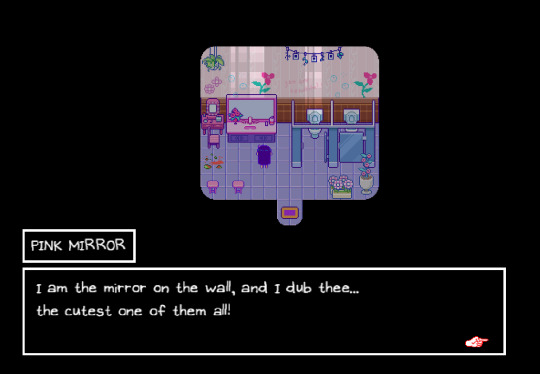
I had never tried to use Aubrey to go into the girls’ bathroom before? it was very cute, I liked it. I don’t know why, but as soon as I walked in it really reminded me of Basil. I think it’s all the flowers, photos hanging from the wall, and general soft cutesy vibe. I’m not really sure what to make of that, but it was just my general impression. hmmmm.
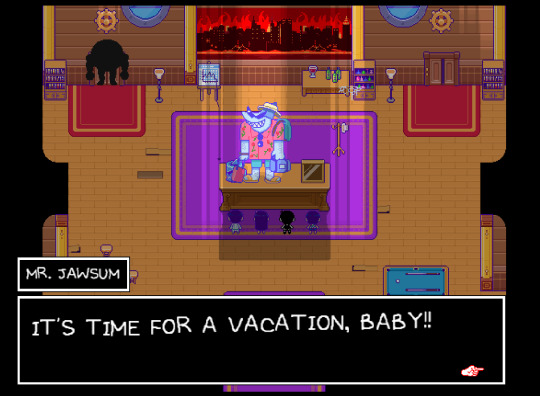
I have no words for this other than it just made me amused. go get your vacation, king.
also:
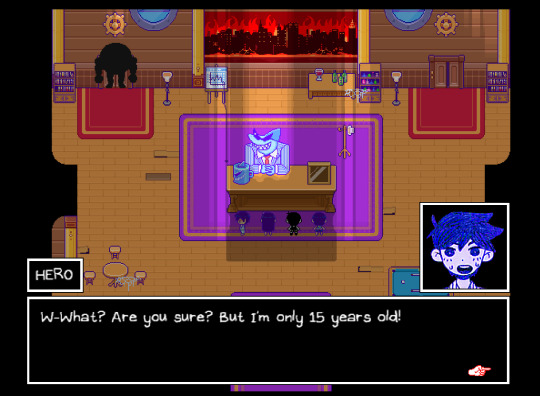
I didn’t know Hero had a confirmed age!! all this time I had been assuming he and Mari were 16 years old, so it’s nice to have something set in stone!
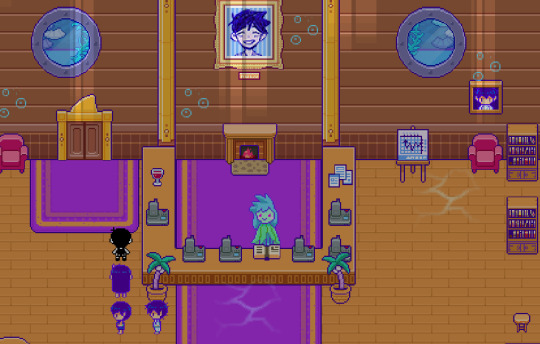
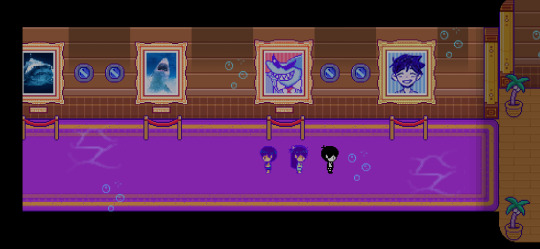
I have no words for these, either. seeing all of the Hero pictures just made me laugh out loud a little I loved it.
when I was standing in Jawsum’s office, I noticed that the elevator behind his desk was shaking. I went to examine it, and was surprised when this was where I ended up.
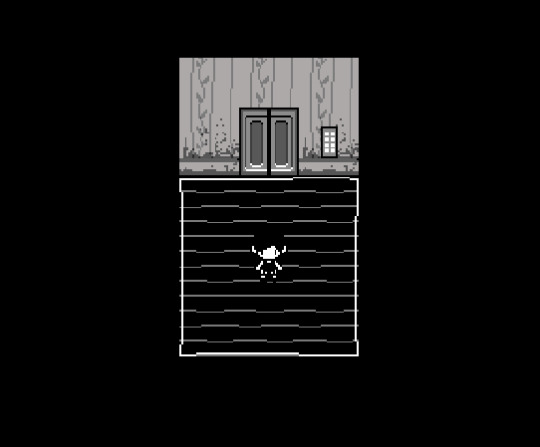
the black space elevator.
something I completely forgot to mention in my last hikikomori post was black space!! it had completely took me by surprise so I can’t believe I forgot to talk about it.
last time I played and went back to Last Resort, there was a completely black car on the highway and it had really freaked me out. as soon as I clicked on it, instead of giving me some kind of prompt Omori just got in and it drove off. I was so shocked because I wasn’t expecting it fhgjdfhgj. it ended up taking Omori back to one of the black space rooms, and I had no clue what to make of it. I wandered around for a little while, and ended up finding this... friend?
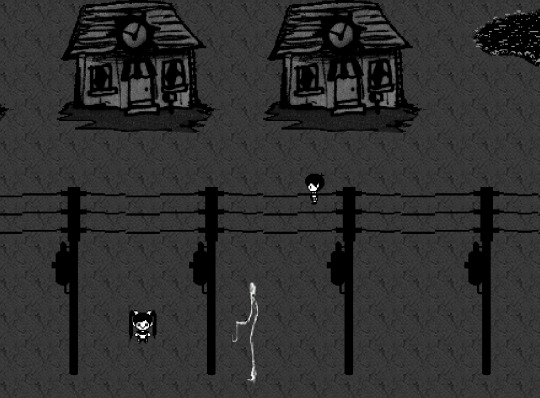
I’m... not sure! who are you......
anyways, so I got in the elevator and we’re back here, now with more spiders.
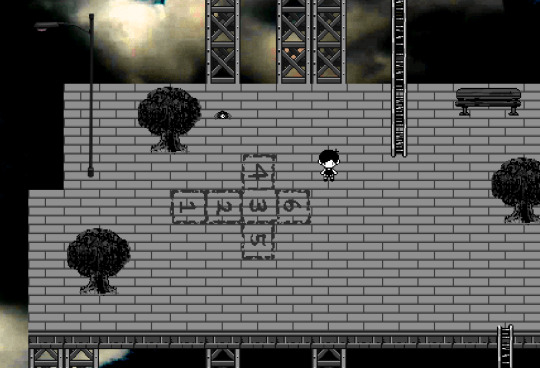
the spider wasn’t interactable. not sure whether to be upset or relieved.
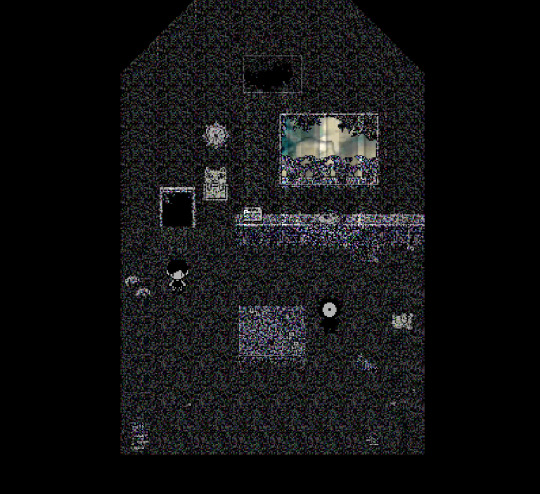
aaaand then there was this guy in the treehouse. I want to know what these black space NPCs are!!! as soon as I tried to interact with it, the screen glitched out (intentionally) and then it was gone. one day I’ll know what it means.
oh, another thing I spent quite a bit of time doing at the Last Resort-
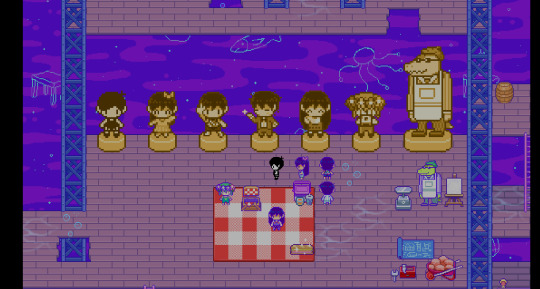
getting statues made of everyone!! RIP to all of my clams, but these are so cute.
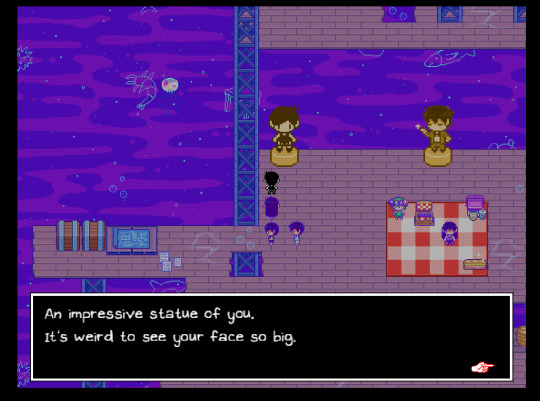
cuuute.
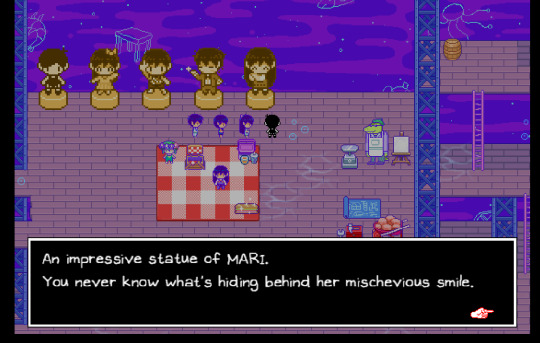
I really liked the comment on Mari’s! it made me happy that it highlighted her playful side.
after I was done reexploring Last Resort, I wanted to go back to Sweetheart’s castle. I was walking through Pyrefly Forest, and I noticed one of the picnic blankets had a cooler open (signaling that you can see a new picnic cutscene) so I went to go sit down and have a picnic.
so, when I was going around earlier and doing some stuff, there were a few picnics that I think I had skipped for some reason so I was doing them and mindlessly skipping through the text for no reason other than it would bother be if I just left them. nothing about the conversations was different even though Basil is here now, so I didn’t think anything would be different for the one in Pyrefly Forest, but I was wrong!! I almost completely skipped through everything aha.
it started off the same, with Hero being scared of the spiders, and then Kel prompted Basil to say something positive to try and make him less scared.

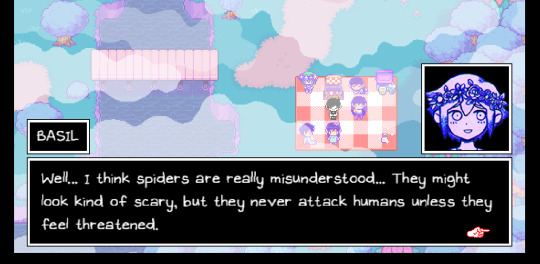
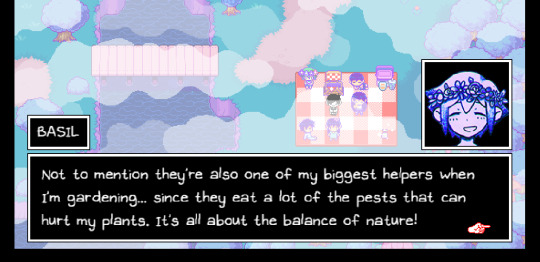
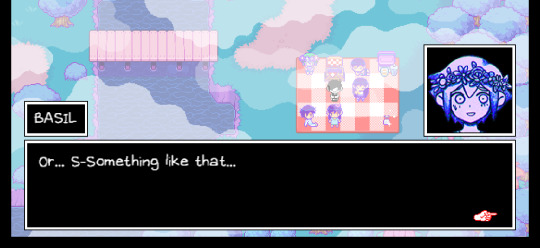
it’s pretty insignificant, but I thought it was interesting that he said pretty much the exact same thing he says in the spider room in black space.
when I got to the castle, I went straight to the library. something about the pattern of going to black space, plus being able to go into the barn in Otherworld, just made me feel like there would be something there. and oh boy was I right. the entire place was crawling with Something.
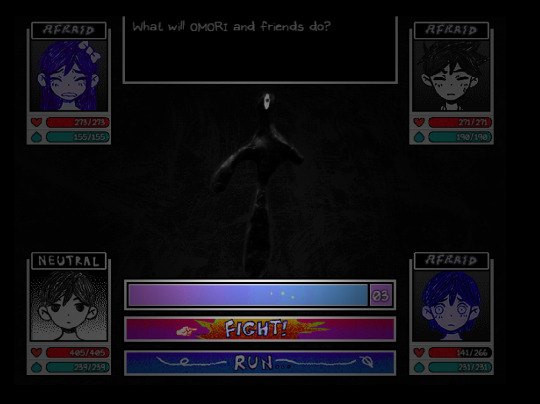
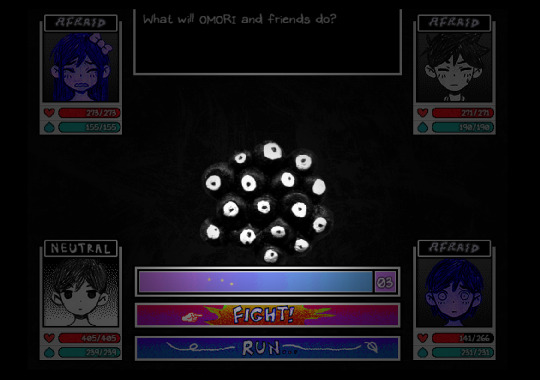
very good.....
I wasn’t able to get screenshots of them, but there were a couple text popups that really stood out to me. my memory is so bad I can’t remember all of them even though it was only this morning,,, but I’m pretty sure one of them had a popup that was just “Liar.” and I was like HM....
it just really had me thinking....
in my previous post, I mentioned that I had a gut feeling that the Something in the barn was supposed to represent Basil, not Mari. this kind of added fuel to that thought!
the barn in Otherworld was only used in the main route in reference to Basil, with it literally showing Omori a vision of him, and also having Stranger walking into it. now, the library also has a lot of connection to Basil! after picking up one of the keys, it shows us another vision of him, and it’s also littered with egret orchids. I don’t think choosing to have all of these Somethings in both of these places is just a coincidence.
now, about the “Liar.” line. in any fight with Something, if there’s a text popup meant to be Something speaking, it’s always done like this-

with the “???:” to indicate character speech. but the “Liar.” popup was just a standalone line. and it instantly reminded me of this room in black space-
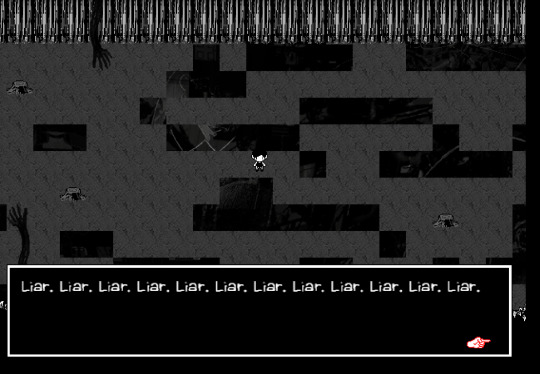
and this just kept making my brain whirl.
in this room, there were all of these popups with “Liar.” and then of course there was-
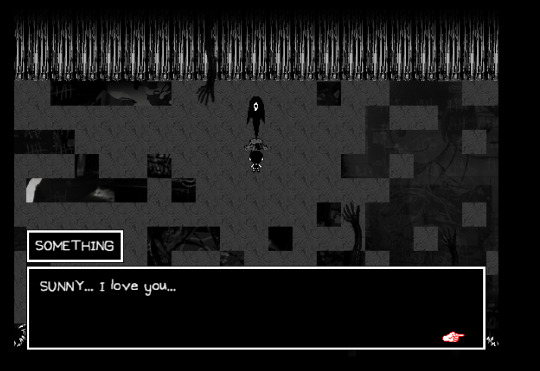
see here how there also weren’t indications of who was saying ‘liar”, but there was for Something? my idea for this room was always that it was Omori repeating it to himself. because we all know by now that Something is Mari, and her saying “I love you”, especially in this form, is nothing but pure torment. and I think here, we have Omori unwilling to believe it. there’s no way Mari could love him/Sunny. she has to be lying.
soooo then, this brings me back to the library. having the “Liar.” popup there, keeping in consideration that the Somethings there might represent Basil, what could that mean?? it could be in reference to Basil’s words “Everything is going to be okay” because clearly everything is not okay. if all of these Somethings are meant to be Basil, it could fit!!!
... so there’s my long winded theory. idk! I think it makes sense, but I could be wrong!! that’s just my first impressions right now, maybe my thoughts will change when I play more!
moving onto the piano room-
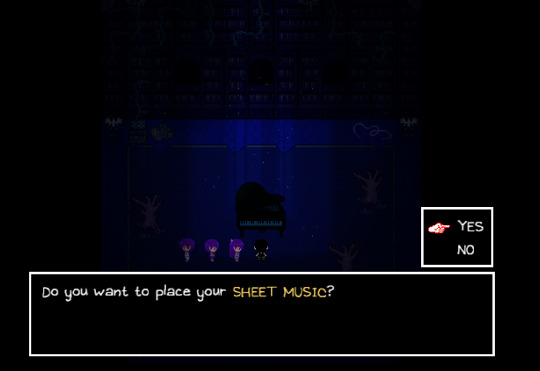
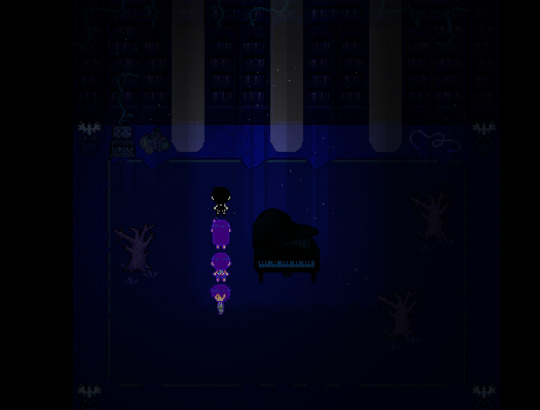
this was when I thought “ohhhh so that’s why the wall always felt hallow. it all makes sense now”
and then I spent the next 30 or so minutes fighting all of the Somethings

I LOVED this. this was the first time a fight was put on a time limit, and since Something was so much more powerful, it felt actually stressful. I was stressed! but I managed to make it with 2-3 turns left, and I didn’t die. I did die about 1 or 2 times to arachnophobia and thalassophobia though F. but it’s okay because I got an achievement and also Omori’s suffocate skill is really good.
anyways I did some more mindless walking around (I had to kill time waiting for all my statues to be built, you know!)
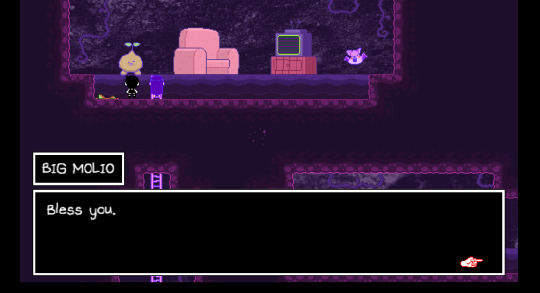
this made me really happy. Big Molio I love you you’re the mvp and you deserve the world.
... looking through my screenshots I wish I could forget this one-

,, do I need to even explain it.
I remember a while ago, I saw someone on twitter post this and iirc the caption was something like “isn’t it a bit morbid to have the jumprope there” and, at the time, I had never gone through Orange Oasis, so seeing that tweet I had the wind knocked out of me. I was just sitting there like “fuuuuuuuuck”. and then I went through Orange Oasis today, saw it again, went “fuuuuuuuuck” and then forgot I screenshot it. it’s just a lot.
okay who knows how I filled the rest of the 6 hours I played because I didn’t take many screenshots of the downtime and running around completing sidequests I never did. the last point of interest today was I had went back to Humphrey.
I didn’t do too much, but I did fight Mutantheart.

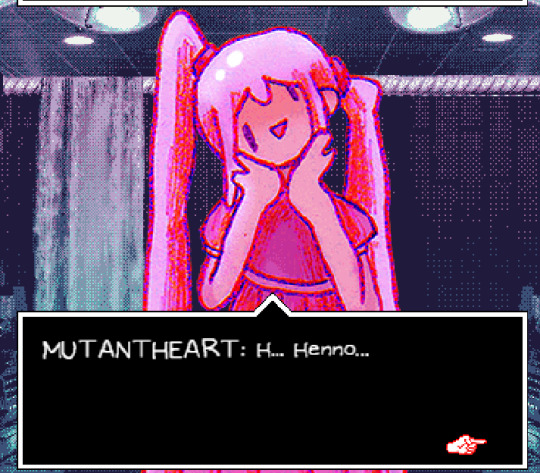
I adore her!!!! so cute!!! Mutantheart my beloved.
I lost to her once, because I was a bit confused, but once I caught on to the gimmick of her fight, it was actually pretty easy. rest in peace, queen, I love you...
and then, uh. Her-
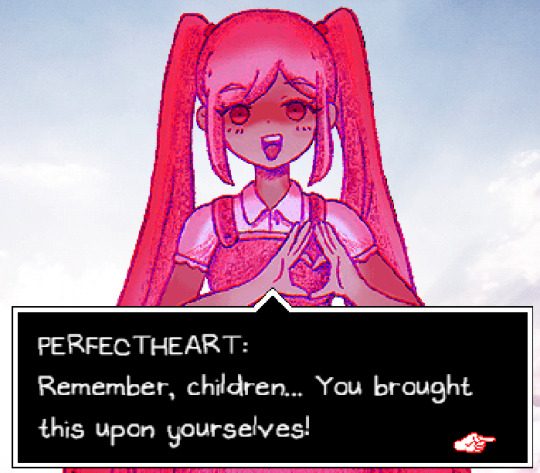
I tried 3 times. I didn’t win... all of the characters are maxed leveled at 50, but this is so difficult... well, the first half of the fight I found to be pretty easy, actually. but once she switches into full power mode it’s over. I don’t know how I’m supposed to win. farewell my dream of completing the foe facts book, it was a nice goal while it was realistic.
and then I stopped for the day! I think I needed that month of not playing, because coming back into the game after a lot of my rage and burnout settled was probably best, and I had a lot of fun playing! hopefully it doesn’t take me another month to continue.
if you made it all the way through this post, thank you for reading! I hope you like my thoughts~
I’ll leave on this note-

king shit
76 notes
·
View notes
Text
FF5 Four Job Fiesta: Part FINAL

I finally did it. We beat Exdeath. It took 26 hours in total, longer than my first playthrough by an hour, but I did it.
I knew I was going to have to grind, and it was going to be a slog so I put on some background noise while I began my grind for experience in the forest and tower sections of the N-Zone. (it had the least amount of brutal enemies)
There, I unintentionally picked up several Dragon Fangs from the Aevis Dragons, an item that would inevitably be the most useful drop I could get from the game. I reached Level 37, which wasn’t ideal, but I stuck with it and made my way back to the last area.
Once again, I began to grind, this time for AP so Lenna could obtain Dualcast. At the time, she was my Red Mage. Once I found out that Dualcast with the Red Mage only allows for the weaker spells, I was pissed because I had spent time getting 999 AP for her. Then, I realized I could just give her back the White Mage class and stick Bartz to being a Red Mage.
You’ll understand why I made such an effort for Dualcast later.
I switched Faris to a Chemist temporarily so she could learn Mix and captured a King Behemoth while I was at it.
With that, we were going to fight Exdeath. Not once, but twice. The first being an experiment, since I learned about a glitch.
You see, if you cast berserk on Exdeath’s initial form by using the Chemist job, he’ll pretty much be stuck in an “offense only” script, that will overwrite his defeat sequence into the second phase. This will completely skip the final boss and take you to the ending after an awkward, shaking screen without dialogue.
Similar tactics are used to break Exdeath in speedruns, so I wanted to try it for myself. I used a Kiss of Blessing on Exdeath, and found myself constantly reviving my party with the Chemist since he was dealing 2000 HP worth of damage. (side note: the Chemist’s ultimate ability can revive all party members without MP, very overpowered)
Thankfully I did set up Protect and left my party members to heal on one end, then attack or cast Holy on free turns. Rinse and repeat, Exdeath was dead but he was so angry that he didn’t go into his second phase. A victory, credits and all, but an empty one.
Even I know that truly beating this game requires facing the real final boss.

Meet Neo-Exdeath, and just listen to his theme.
This fight… took about four, maybe five times before I got my strategy down. Dear god.
Firstly, we set up our defenses on Exdeath’s previous form, casting stuff like Protect, Shell, and making sure my Chemist ingested Giant and Speed Drinks.
Next, since I gave the Mix ability to Faris, I let her use the Dragon Fangs I collected to create Dragon Power, something that would boost the level of my party drastically so they could do more damage, especially Lenna.
Once we got to the Neo-Exdeath phase, we had to get that Magic Lamp out. Bahamut and Leviathan are good damage dealers while Odin will kill that segment of Exdeath all the way in the back, saving us trouble. After which, Faris would unleash the King Behemoth that was captured to deal damage on all three remaining halves.
With one out of four of Neo-Exdeath’s halves gone, I immediately had Lenna Dualcast Holy on what remained. Krile would attack with the Chicken Knife or revive, Faris would use the whip or mix items, and Bartz was stuck as the healer mostly but also functioned as back-up Holy.
Once every few turns, usually after he uses the annoying Almagest, a magic damage attack that deals hefty damage to the entire party. Sometimes it will be immediately followed up with Grand Cross. Unlike FF9, we don’t have an Angel’s Snack to deal with whatever Neo-Exdeath decides to cast on us.
Usually one party member gets stuck with Silence, our Red Mage stuck in Berserk, and someone else gets turned to stone. To my luck, Neo-Exdeath didn’t use Zombie or any Doom-related ailments, so I never had to worry about a countdown timer. I ran out of eyedrops, so I couldn’t mix a cure for any of these ailments, but I did have a spare Soft to get rid of being petrified.
Since Lenna had been beefed up from the Dragon Power, she was consistently dealing 9000-18000 damage with each Holy dualcast. Sometimes I would have to sacrifice a second Holy in order to heal, if only to survive whatever physical attacks he could throw my way.
Sometimes Neo-Exdeath will use Dispel, which will undo buffs on a party member. Easy enough for Krile to remedy through another Speed Drink, but Bartz and Lenna were often stuck recasting Protect and Shell.
After killing off two more of Neo-Exdeath’s halves, he pretty much goes into a desperation mode, something that nearly all final bosses in this franchise do. He’ll start casting Meteor much more frequently, but will then burn himself out really badly and use a wimpy Comet attack that barely makes a dent in my party.
I constantly heal and cast Holy at this point, and ignore putting up Shell again since there’s no point this far into the battle. I’m getting as desperate to kill him as he is to rid of my party. One last stab from Krile’s Chicken Knife, and that was it.
The battle was over, for real this time since I finally killed Neo-Exdeath. The world is saved from being sent back to the void.
I watch half of the ending… aaaand my game freezes, for some reason. Don’t worry, I think something is wrong with the emulation or my PSvita, because it did that the last time I reached the ending to this game. I’m still very much satisfied with just defeating Neo-Exdeath, end credits not required here!
As for my overall playthrough rating…

Lenna Charlotte Tycoon - White Mage
Ability: White / Dualcast
White Mage is an MVP you want on any team. Healing and Holy is just the way to go. Being stuck with bonking your enemies with a staff isn’t as bad as it seems, as you can tell from the first part of this playthrough.

Bartz Klauser - Red Mage
Ability: Red / White
Oooooof… jack of all trades, master of none. This class was good early game, but falls apart so badly. Magic and equipment both get really mediocre in the late game, and it has the lowest HP. Really wish I had gotten the Summoner instead. Yeah, probably the least good of the jobs I got. The only saving grace is Dualcast, which I gave to Lenna.

Faris Scherwiz - Beastmaster
Ability: Catch / Mix
Beastmaster is a really fun physical class! It’s best used when paired with a Blue Mage, but we didn’t get that. Still, probably the most capable in terms of physical offense, and I got some good use out of capturing monsters and controlling them. Wish the whip was a bit more accurate though at times.

Krile Mayer Baldesion - Chemist
Ability: Drink / Revive
I was so scared when I rolled this one because I had no clue what to expect. I had no idea this would be the job that saves the fight against Exdeath, with its mixture and revival abilities, no MP required. If I ever play this game again, I am going to definitely utilize this job more, it is now a favorite of mine.
Overall, despite my gripes with the last half of this game, the rest of it and the final battle have been so much fun. I can’t wait to talk more about it at the end of the year. I also really enjoyed coming up with new strategies with the jobs I was given.
Thank you all for reading. If you haven’t played this game yet for some reason or done a Four Job Fiesta, I highly recommend it.
2 notes
·
View notes
Text
Please Don’t Sleep on Hades

2020’s…been a real year, huh? At a time when in-person gatherings aren’t much of a thing and people have to stay in, video games are suddenly a pretty attractive option. That said, few games have really grabbed me this year; in a roundabout way, 2020’s been a year of reruns, as I go through a lot of games I’ve already played or games that are just yesterday’s news (but new to me!). However, in the nick of time, the folks at Supergiant Games delivered unto us their latest title, Hades. While they’ve been working on this game for years, with it hitting Early Access on Steam back in 2018, the full version of Hades finally hit Steam, the Epic Game Store and made the leap to consoles with the Switch, which is where I picked it up. It has been a WHILE since I’ve had a game grab me so strongly so early on, and I’ve been hearing this game’s praises for years now already, so allow me to happily state why I think Hades is worthy of the hype and is a fantastic game I’d easily recommend!
DADDY ISSUES
OK, so first things first…you don’t actually play as Hades in this game, but rather his son Zagreus. Ol’ Zag has had it with his father, and tries to literally fight his way out of hell to reach the surface, and no matter what his old man puts in his way, Zagreus (and the player) will meet the challenge. And probably die, but hey, that’s OK! In the underworld, death is more of an inconvenience than anything else, so after taking a moment to dust himself off, Zagreus will head out for another attempt. For as long as it takes.
Hades is a rogue-like, meaning it’s a game based around randomization and adaptation. On any given “run” of the game, the level layouts, enemies present and the variety of power-ups Zagreus can find will be left to chance, with the player challenged to amass the best build they can to eventually break out of hell and reach the human world and if you die…start from scratch. That said, Hades is among the ever-growing sub-genre of rogue-lites, in that there IS some permanent progression, which takes a bit of a sting out of dying, but more on that later. Now, most games of this type aren’t really big on story. They have a premise that’s little more than an excuse to play. Splunkey wants you to explore a cave, The Binding of Isaac sees you escaping a basement and in Enter the Gungeon you uh…e-enter the gun—you get the point! But what separates Hades from most rogue-likes/lites is that there actually IS a very interesting story that unfolds as you play.
There’s more to Zag’s desire to get to the surface than just getting away from his father, though their strained relationship certainly doesn’t help matters, and over the course of your many, MANY escape attempts, players learn of the rather screwed-up nature of Zagreus’ family of deities, though any mythology nut could tell you to expect that. Hades has an incredibly charismatic cast, superb voice acting across the board, and some real sharp writing that really got me wanting to meet anyone and everyone and learn more about this world. You’re likely to run into Hypnos first, who always has a “tip” ready for you when you meet your end to a given enemy or hazard, or the fabled hero Achilles, who acts as a mentor to Zagreus. There’s Dusa, the adorably frazzled flying gorgon head who acts as the House of Hades’ maid, and of course…Megaera, of the Furies.
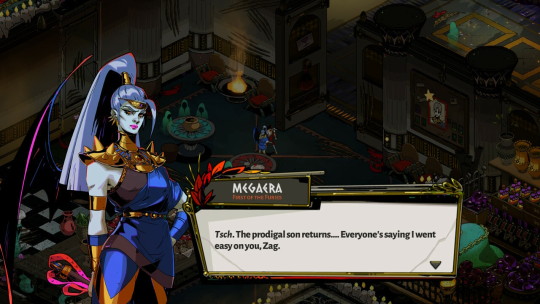
She serves as the first proper boss in the game, and will be a pretty sizable challenge for most players, but as you eventually overcome her again and again, she and Zagreus end up attempting to reconnect with each other, and her recurring fights become an excuse to flirt and test each other. I may as well say too that it’s easy to fall in love with the characters in this game because…I-I mean, just look at them! This game is a bisexual’s paradise, that’s all I’ll say.
A bit of a fun fact, but Zagreus’ voice actor, Darren Korb, is also a composer at Supergiant, so he’s a man of many talents, since Hades has a killer score. From the laid-back tunes at the House of Hades where you can unwind and recharge after a botched run, to the pulse-pounding boss theme, there’s some GREAT music on display here. And that’s before you meet Orpheus and Eurydice, two characters with amazing singing voices that, if you play your cards right, might start singing together. The game’s visuals, meanwhile, aren’t a slouch either. While the level layouts are randomized, everything manages to look well-crafted, each region of the underworld having their own distinct look and feel. The fiery pits of Asphodel end up juxtaposing well with the paradise that is Elysium. Now, character models are generally less-detailed since the camera stays zoomed out to give players a good view of the action, but the portraits for the various characters more than make up for it with their distinct, detailed designs. A-And I’m not just saying that because everyone’s hot! Now, admittedly you might take a look at Zag and think he’s nothing but an edgelord and the game itself might be taking itself too seriously, but in reality, Hades strikes a pretty good balance, and definitely carries a sense of humor. Characters love to snark at each other, the various Shades chilling in the House of Hades’ lounge have some funny conversations you can listen in on and all told, the game only gets serious when appropriate. Really, I have no real complaints with the game on a presentation level; it’s all aces so far, and thankfully the game-y part follows suit!
LIVE.DIE. REPEAT.
Hades is best described as a dungeon-crawler. You have an isometric view as you move about, avoiding hazards and fighting off enemies as you climb each chamber on your way to the surface. Defeat every enemy in a chamber and get a reward. Sounds simple enough until you factor in all of the various permutations of events; Hades aims to make sure no two runs are alike, with different enemies, power-ups and challenges awaiting you. All of this is doled out slowly, as with each subsequent playthrough you begin to have more of the game unraveled. First and foremost, Zagreus can gain various Boons from the other Olympian Gods, who are sympathetic to his plight and lend him some power if he makes contact with them. Each God has their own twist on the abilities they grant Zagreus. They can all increase his stats in some way, or affect either his dash ability or his Cast, a projectile attack. For Zeus, naturally, all of Zagreus’ moves will gain an electric effect, whereas Artemis focuses more on upping Zag’s critical hit chance. Dionysus, the God of Wine, grants you the “hangover” status effect, allowing your attacks to uh…make enemies drunk? Sure! You’ll be given a random selection of three Boons to pick from, of varying rarities. Over the course of a run, you might try to nab as many Boons from the same God as possible, or vary it up and see which abilities synchronize together. At times, you might even be granted a Duo Boon, where two Gods decide to combine their power for a special ability that plays to both of their strengths. Still, at other times, you might be forced into a Trial of the Gods, where you must choose one God’s Boon over the other, with the snubbed God lashing out afterwards. Hey, just because they’re Gods, doesn’t mean they’re nice. Of course, you’ve also got a variety of health and weapon upgrades too. In fact, let’s gush about the weapons for a second, shall we?

At the time of writing, Hades has six weapons to play with. You start with a sword, which is the all-rounder of the set, but as you gain keys to unlock more weapons, you can start to really experiment. The bow and rail cannon serve as ranged options with different approaches, while the spear is the melee weapon with the best range at the cost of pure power. The shield grants you absolute defense at the cost of range, while the gauntlets let you unleash your fisticuffs on underworld scum, though leave you with limited ranged attacks. Each weapon has specific Boons and weapon upgrades you can find as well, some of which can radically alter how a weapon works. The rail cannon, for example, fires a lot faster than the bow, but this is balanced by needing to manually reload…unless you get a weapon upgrade that gives you unlimited ammo with the only catch being that you can only do burst fire. Adding to this, players eventually unlock hidden Aspects of weapons, morphing them into different forms which can also influence their moveset. Change the shield to the Aspect of Zeus, and when you throw your shield Captain America style, it stays out and continually spins, dealing tons of damage over time and effectively forcing enemies to get sliced to bits if they want to get near you. I didn’t expect this game to have half this many weapons or to have them balanced so well. Really, just like anything else, weapons are another tool you can poke and prod and experiment with until you get a truly killer collection of Boons and upgrades that let you just demolish anything in your way. It’s very satisfying when you finally clear a run with a great build…though depending on the RNG, you WILL get some crummy builds, but that’s the nature of the rogue-like!
It’s likely that a bad build (or really, just getting hit with a new boss or enemy you aren’t prepared for) will lead to a death, but as already established, death isn’t really that much of an inconvenience in the underworld. Zagreus just spawns back at home and is free to immediately try to escape again, but this brief reprieve lets you chat up whoever happens to be around, give them gifts, advance some side-quests, pet your dog Cerberus and practice with weapons and such before you’re ready to go at it again. It’s after a run that you also get to spend a lot of the spoils of your escape attempts. While you lose Boons and weapon upgrades and the like upon death, there’s a LOT of various items you keep with you that have plenty of uses. Darkness shards are used for permanent skills that can be applied to Zagreus, like Death’s Defiance, which grants Zagreus another life upon dying, which can eventually be upgraded to give him THREE extra lives, just as an example. Precious gems can be used to fund a variety of cosmetic changes to the House of Hades. Just because Zagreus doesn’t want to live there anymore, doesn’t mean he can’t at least make it look good! Nectar can be gifted to other characters to improve your relationships with them, with bottles of Ambrosia being required later on, while special keys can be used to unlock weapons, more upgrades for your Darkness shards, or just used as a secondary currency for trade. There’s really a LOT of different items to mess around with, though admittedly if you’re the type to want to max out EVERYTHING you’ll be in it for the long haul, as there is not only a LOT of stuff to upgrade and purchase, but the random nature of things means rewards are never a guarantee. Though it’s worth noting the game’s totally beatable without going nuts with completion. Which I guess leads me to the biggest compliment I can give this game: even after “beating” it, I still can’t stop playing, and there’s plenty of reason to keep going.
REPLAYS AND REWARDS
So, full disclosure, I’ve gotten Zagreus to the surface. Several times, actually. But I haven’t quite “beaten” the game yet. In fact, at the risk of sounding pretentious, it is as if the true game begins after you’ve beaten it once. Without getting into specifics, let’s just say the game gives you a very good in-story reason to keep playing, and you won’t reach credits without several completed runs under your belt. And even then, there’s still stuff to do. I’m almost 30 hours into Hades and I’ve barely scratched the surface honestly. Every major character has their own sidequest you can undergo, but it can be slow goings when it comes to advancing them. Trying out all the weapons and boons and different combinations will easily take dozens of hours to fully experience, though the game has a handy in-game list of what you’ve done and haven’t done, as well as in-game achievements with tangible rewards that will spur you on. I was admittedly surprised at how dense of a game Hades can be. A successful run will likely take you somewhere between a half-hour to an hour, which is pretty devious. Just long enough to stay engaging throughout, and short enough that I can keep convincing myself that I have time for “one more run” and then suddenly several hours have gone by. Strangest thing.

Something that’s become a bit of a staple of Supergiant’s work is customizable difficulty, various modifiers you can flip on to make the game harder if you so desire, which in Hades takes the form of the Pact of Punishment. After a successful run, you can turn on a given pact to spice things up for subsequent runs. Maybe enemies do a bit more damage, or you give yourself a super strict time limit to clear a run. You can give enemies armor that makes them sturdier, or jack up the in-game shop’s prices. You can even be forced to give up Boons in order to advance past certain doors! Probably the most impressive Pact is Extreme Measures, which ends up greatly affecting the boss fights in the game…trust me when I say you won’t be ready for them the first time you flip that on. Activating a given pact increases a “heat gauge” that, should it reach a given level, will end up granting you various special items to help with fully upgrading and unlocking stuff. Of course, with each successful run completed with a given Pact activated, you’ll have to raise the heat more and more in order to keep getting these upgrade materials so be prepared. You can also still gain these materials (albeit at a much slower rate) playing through the game normally though, and there’s really no penalty for choosing NOT to activate a given pact. On the flip side of things, there’s also a God Mode you can toggle on that makes Zagreus a little stronger with each death, which can help those that want to see more of the story but are struggling with the game. Have your God Cake and eat it too!
All and all, this game just delivers on every level and I’ve been devouring it since release whenever I have a spare minute. You can see that Supergiant is taking all the lessons they learned from each previous game and combined it to make what is easily their best game yet. I don’t throw around words like “masterpiece” lightly, but Hades is just such a slam dunk that I’m sorely tempted to call it just that. I mean, if you hate rogue-likes, I’m not sure if Hades will really push you over the edge admittedly? You get way more rewards retained after death than just about any other rogue-like I’ve played, but if you’re the type that hates having to constantly adapt and not being able to memorize what’s coming, I can see this not working for you. But for me at least, I’ve had an absolute blast with the game and the only issue I really have with it is a small nitpick at best. When it comes to getting to know various characters, you can talk to them and give them Nectar or Ambrosia as a gift right? But what happens if they don’t show up on a given run? Or what if they DO show up, but they’re locked into a conversation with someone else? That means you can’t really advance anything with them until a given dice roll pities you. MEGAERA I THINK YOU’RE COOL, PLEASE JUST TALK TO M—oh sorry, don’t know where that came from… So yeah, that’s the nittiest of picks.
I adore this game’s cast, the voice work and music is excellent to the ear, the combat is engaging, the gameplay loop is addicting…need I say more? I mean, I’ve said almost 3000 words, but to really sum it up…I highly recommend Hades and I hope you don’t pass it up if you’re even remotely interested. You can find it on Steam, the Epic store and Switch as of right now, and I don’t think you could go wrong with any version.
Blood and darkness await you.
-B
#Hades#Hades game#supergiant games#hades supergiant#zagreus#megaera#rouge like#nintendo switch#xb-squaredx
7 notes
·
View notes
Text
Top Ten Songs of 2020
This was actually a shitty year for me regarding music. Between stress with, well, everything, depression, and mental exhaustion, I didn’t have a lot of mental bandwidth to dedicate to discovering new artists and listening to them in their entirety. But even with the mental and emotional blockade preventing me from really delving into the new artists I did discover, I managed to listen to enough music to create a top ten list, and because I’m bored at work, I’m going to share it with you all. Feel free to reblog with your own top ten so I can see what songs comforted you during this absolutely wretched year.
These songs may not necessarily have come out this year. I’m basing this list on the fact that I discovered these songs this year.
10. Pulled Out of the Market by Ondara - I found this song pretty early on this year. It’s about COVID and the job crisis and, I dunno, there’s something about the sorrow in the singer’s voice that just breaks me every time I listen to this song.
9. E Girls Are Ruining My Life by CORPSE and Savage Ga$p - It’s aggressive and ugly and awesome. I found this song about two weeks ago while I was in quarantine and it’s been on repeat ever since.
8. Little Dark Age by MGMT - It’s a great song in general but the line “I grieve in stereo” just punches me in face every time I hear it. My grief might be inside me, and I might be handling it, but it’s still so loud sometimes.
7. What’s Your Pleasure by Jessie Ware - Sometimes we just need a simple, fun pop song about sex.
6. La La by Kids In America (feat. The Mowgli’s)- I listened to this on repeat while waiting for my COVID results. The results that came back positive the day before my birthday. The chorus of this song is, “I just wanna la la la la” and somehow that resonated with me because it’s so vague and i felt that. I didn’t know what to do with myself anymore so it felt appropriate. What do I do? I guess I’ll just *gestures vaguely* la la la la
5. Are You Filming Me by twst - it’s a totally boomer thing to say but we are surrounded by technology, always filming ourselves for TilTok or Instagram, we have our conversations recorded and then analyzed so Facebook can cater oddly specific ads to us. It can feel a little unsettling at times, and this song really plays on that tension and paranoia of feeling like you’re never truly alone.
4. Sad Happy by Circa Waves- Basically my theme song for this year. Fun little dance pop number but the lyrics are about how the singers heart is made of concrete. It reminds me thematically of the song “Dancin’ With Tears in My Eyes” by Avantasia which is another incredible song and would probably be at the top of this list but I discovered it last year.
3. Only Going to Hurt You by The Ninth Wave - The understanding that you’re inevitably going to hurt the person that you love. The admission that the person you love can be equally as cruel. The fear of being hurt further. Great song.
2. ily by Surf Mesa feat. Emilee - A remix of the awesome “Can’t Take My Eyes Off You” by Boys Town Gang but they really make it their own. Instead of a fun dance pop tune you get a soft and serene lo-fi sort of sound, and it feels like wrapping up in a warm blanket. It’s a very comforting song. Plus, I sing it to my cats all the time.
1. Deep Blue by The Midnight - I’ll admit: this song was heavily played during my most recent Dragon Age: Inquisition playthrough as the theme for Dorian and Bull’s romance. It just fits. But I had this song on my radar before I began playing DA:I again, and I’ve loved it from the moment I heard it. I love the idea of the singer not searching for love and being upfront about it. They just want to have a good time. But then the thing they never expected, or even really desired happens, and their rushed descriptions of what love is are so seemingly simple but so powerful. I love the passion of this song. The excitement of falling in love despite never really thinking it was for them. And then the epic sax solo. This is seriously a wonderful song, and a thankfully sort of optimistic one to end on. This song fills me with excitement for the future.
#I’m bored ignore me#top ten music list#I didn’t include musicals bc if I did then this list would only be hadestown and beetlejuice
1 note
·
View note
Text
I Prefer Your Love
A continuation to the Gat/Boss request I posed earlier today, because now we’re deep in the pain of Saints Row Three with Boss Ellis lol. Also, I’m just really having fun writing these two up, their relationship, everything. I really wanna go back and give them more Gat/Boss/Aisha time too (because I love Aisha dearly, and she really is the brains of the group, even if they won’t admit it every time lol.)
This is written pre-acquisition of Matt Miller in SR3 (aka about where I am in my current playthrough lol) but I plan to feature him in other fics with Boss Ellis!
Major TW for suicidal ideation, suicidal attempts via gang violence, and definitely PTSD that, for my boss, is dangerously undiagnosed (though to be fair, I think we could safely say that’s a dx for all the Saints.)
Also hey, wanna cry while reading this? Here’s the two songs I had most on repeat while writing this that by the end had me tearing up in how they relate to the fic and Ellis’ and Johnny’s relationship (also the first one is where I got the fic title from): https://open.spotify.com/track/0Snb87Z4Zdn6YFMicWA7gx?si=i_mPPaSlTJq_9LIUdsHw6A and https://open.spotify.com/track/0pY9xoiH9hNo166spIpQWt?si=HK5w7Y3YTNOuIFZv8RKxLw
My love to all who read/like/reblog!
His phone goes off mid-fire-fight, and he resists the urge to be too upset. When it rains it pours, and this pouring isn’t anything new.
“Where the fuck are you?”
“Gosh, the sound of gunfire might give you a hint,” Ellis replies with a deep sigh as he swings around to take out another Decker. “Why?”
“No! I can hear you’re fighting, but where exactly are you?”
“By Nobody Loves Me, where are you?” he sasses back. “I’m busy.”
“Oh my god. We’ve been terrified, no one could find you last night-”
“Shaundi, can this wait?” he tries to sound sympathetic, but there’s none right now. “You guys didn’t even call me, or text. I checked my phone. It can’t have been that emergent.”
The line goes dead, and he focuses back on the fight. There are more Deckers than he expected, and he’s starting to notice the lightheaded sensation of blood loss and bullet wounds now, but so what?
Johnny would be proud of that, if he went down in a hail of bullets.
Before he can take out the latest Decker, a kid who looks too young to be out without his parents, let alone in a gang, he’s up and in the air.
“Oleg, put me the fuck down. I’m ending this.”
“They will end you my friend, if you stay. You can end things another day. For now, we need to get you to the hospital.”
“I’m fine!” his struggling means nothing to Oleg, not even as the butts of his dual-wielded pistols hit the man’s massive fists. “Put me the fuck down, now! That’s a goddamn order!”
But he’s in the back of a truck, still held gently by Oleg, who ignores his fussing, his spitting of literal blood, and it’s then that he starts to realize it’s rather hard not to choke on it.
“Stop talking,” Oleg finally says softly, and that’s the last thing he hears.
**
The light is so bright, but he can see purple. Purple is good, if he could feel it, he’d know the texture, Johnny’s usual favorite jacket, the one he’d lend to Ellis whenever he got cold, the one he loved having him wear when they fucked, just the jacket and nothing else, and-
“Pierce?”
“Well goddamn. Sound more disappointed, why don’t you,” Pierce scolds him. His head is in Pierce’s lap. Why is he laying in Pierce’s lap?
Sitting up, especially quickly, is a terrible choice as it turns out, and he vomits into the bucket near the couch as he flops back down.
“Thankfully, I didn’t wear a nice suit today,” Pierce remarks wryly. “How you feelin’?”
“Like shit. But I felt like that before getting shot.”
“Yeah, but you got shot a lot. Like, enough that you shouldn’t be here. And you probably shouldn’t be here, in HQ right now, but we know you got your thing about hospitals, not wanting to wake up in ‘em, so we convinced the doctor to let you recover here. He’ll be coming by to check on you-”
The tears come before he can stop them. “Why did you do this?”
“The hell are you talking about?” Shaundi’s voice from behind the couch. “Do what? Save your ass?”
“I was so close to him,” Ellis whimpers. “I could taste it, in between the blood and the gun powder. I was almost with him again.”
They go silent except for a sharp intake of breath from Pierce. “Boss-”
“I was almost with him again!” he’s screaming and it hurts his chest, his lungs, but nothing hurts more than his heart right now. “And you took me away from him! How fucking selfish of you all-”
“Selfish?” Shaundi interrupts, with a shocked scoff. “Excuse me?”
He stands, but it hurts so bad he could pass out, but he fights off the darkness threatening to encroach on the corners of his vision, but he can’t stop moving now. “You fucking heard me. You took me away from my husband!”
“No one took you away from Johnny!” Shaundi’s voice is sharp in his ears, like a knife in his side. “Loren took Johnny away from us! You were just out there trying to get yourself killed, like you have a death wish or someth-”
She interrupts herself with a gasp, a hand flies to her mouth.
“Oh, don’t look so fucking surprised,” Ellis spits. “And I was this close to making it. I was going to see him again. Hold him again. Kiss him again, apologize for letting him die. And you fucks took that away from me.”
He ignores the footsteps following him as he stumbles out the backdoor of the living room to the pool area, around the slippery flooring to the helipad. One of their smaller planes is still there, and there’s a haze from the narcotic pain pills they must have given him at the hospital, but it isn’t the first time he’s flown while high.
But it might be the last, if he does this right.
“Get him out of that!” and he’s never heard Kinzie be that loud so far. She could go far in the Saints, if she could yell that authoritatively more often. She’ll have to, maybe, once this is finally done. She’d be a good second hand to Shaundi, if Shaundi steps up and takes over like he hopes she will.
In any case, it’s too late as he takes off, and pays sparing attention to the controls as he flies, at times only resting his knees on the controls, the plane bobbing and weaving up and down and entirely too close to buildings.
It’s all quite funny, until a sharp clearing of the breath in the passenger seat.
“The fuck are you doing?”
Ellis shrugs, and reaches over for Johnny’s hand, but feels nothing. “I’m going to find you. I can do it.”
Johnny shakes his head. “No, you can’t, and no you aren’t. I’m not even real right now, you know that. I know you do. You’re only seeing me because you want to, because you need help, and for some godforsaken reason, you only want it from me, and refuse to let anyone else in.”
“Why would you say something so cruel,” he pouts as he nudges the controls at random, enjoying the turbulence. “I just want to be with you again. You wanted to be with Aisha, and you are now. I miss you both, so why can’t I come be with you?”
“I could tell you it’s just because they need you,” Johnny replies softly as he takes off his sunglasses, and the tears come again as Ellis sees his eyes, the most gorgeous he’s ever been lucky enough to look into. “Or just because it isn’t your time yet. And those two things are true, by the way.”
“Stop,” Ellis begs him, a whisper.
“Go land on the island,” Johnny instructs.
Below them, the island where the plane Johnny had been on, had died on, had crashed.
“I don’t want to land. I want to crash. I can be done, with all of this,” he weeps. “Don’t you want to see me again? Don’t you miss me?”
There are tears in Johnny’s eyes now too. “Of course I do. I love you. But this isn’t the way, I promise. I know you can’t understand it right now, but you will see me again, just not the way you’re thinking or how you’d expect. Don’t do this.”
He lands, admittedly difficult on the small and bumpy island, but he manages. As soon as they’re safely stopped, he clambers into the passenger seat, into what should be Johnny’s lap, he can see it, but he can’t feel it as he sits there, and the lack of sensation is worse than being shot with any bullet.
He sobs, and wishes for Johnny’s arms around him, even as he hears the soft and sweet words in Johnny’s voice, urging him to just listen, for once. “Get on the boat when they get here. Take a break, for a few weeks. Let them handle shit. Come back to me, to yourself. I know how shit gets for you, how bad it gets in your head, how hard this is, but it isn’t worth it. I need you to stay here with them. We’ll be together again, I promise.”
It’s nearly dark by the time the rest of the Saints arrive, and he lets Shaundi, her make-up running down her face, breath hitching as she cries, help him out of the plane. Pierce, sniffling, is the one who keeps him upright when he slips on the edge of the boat, and it’s Kinzie who helps him settle on the backseat of it.
“Oleg would have sank it,” she tries to giggle, but her eyes are red and tired looking, and it falls flat as he leans against her. “Otherwise he’d be here. But he’s back at HQ, waiting to help get you into your room.”
“That sounds nice,” and he means it to sound that way genuinely, but he can hear how flat his voice is. Nothing he does can make it sound better, and he isn’t sure it matters anyway.
He doesn’t hear Johnny again until he’s back at home, after being gently washed by Oleg of all people, who tells him a tale of how he used to work as a medic for some friends of his who got in bad situations of varying sorts, and they always requested him for sponge baths while horribly injured. “Apparently, my hands are very gentle. It is a nice thing to hear, don’t you think?”
He can’t respond, and doesn’t try to until he’s alone, and Johnny is back too.
“You can’t do this again.”
“Then what do I do?”
“You keep fighting. You keep working. You stop pretending that you’re just magically okay, and not hurting. You let them in. You let them help. And by the time you get back to me, we’ll both be doing better.”
He can’t stop the tears again, even though it hurts his eyes to cry again, so sore and dry from the weeping he’s already done for the day. “I’m not going to hear from you again after this, am I?”
He swears, he’s certain, he can feel Johnny’s lips on his for just a second. “No. But you will get me back. Did you really think I’d leave you alone forever? Didn’t we both say we wouldn’t do that to each other?”
He nods, and then Johnny is gone, and the bedroom is entirely too big and quiet.
And it’ll be like that for a long time, he knows that now. But a person can get used to anything, so long as it’s temporary.
And he can do it, for Johnny.
Johnny would be proud of that, of him keeping on, even when everything inside of him is screaming at him to stop.
Johnny would be proud, and he’ll live to see him be proud, if it’s the last thing he does.
2 notes
·
View notes
Text

Minit
Developer: JW, Kitty, Jukio and Dom Publisher: Devolver Digital Rrp: £6.99 (Humblebundle and Steam), £7.89 (Gog.com) Released: 3rd April 2018 Available on: Humblebundle, Steam and Gog.com Minit is what a Legend of Zelda game would look and play like if it were boiled right down to its base elements. Find the quest, complete the quest, use the item you get to complete a different quest, rinse and repeat.
youtube
In Minit you only have one minute to do anything before you die. Thankfully after each death you get to try again and if you happened to have found any equipment on that last try you'll have it either upon your person or positioned near your start point. This makes this a game of lots of short runs rather than one long one, you have to manage your time. focus on a singular goal or quest at a time and hopefully you'll complete it before the time runs out and you die again. However several quests actually require you to die a few times before you can complete them. Aesthetically Minit is very simple working with a palate of just black and white, but considering that the developers only used two colours they managed to achieve quite a lot.

This is by no means a long or even exceedingly complicated game but what there is of it is absolutely filled with charm. You can even complete the game without finding half the things that are hidden around, in my first playthrough I only found 44% of the worlds treasures. I did better on subsequent runs but I never broke 80%. This is definitely a game to give a look into, if only because the idea is one that isn't often used in video games (not saying its never used I can name a few that use a similar mechanic). It's a lot of fun and I like the way that a lot of the quests aren't really spelled out for you requiring a little intuition on the part of the player.
#minit#Devolver Digital#jw#kitty#Jukio#Adventure#adventreu game#independant#indie#indie games#video games#video game#game review#game reviews#games review#games reviews#black and white
4 notes
·
View notes
Text
Wow, a lot can change in about a year, huh. I was there for TB2, but tapered off it and TB1 sometime for real-life reasons, just before the Girls Gone Astray event in 2… but I’ll leave my thoughts for the end of this (the playthrough).
With version 5.5.3, Terra Battle now has an ending. For the most part, I’m going to be aiming just to finish that. I got to chapter 36 before I stopped playing, so chapter from now to at least chapter 34 will be several versions behind. But nevertheless, onwards:
Chapter 30: Rising World – “The will of countless creatures great and small converges into a single purpose: to protect the future.”
30-1 They live solely for vengeance.
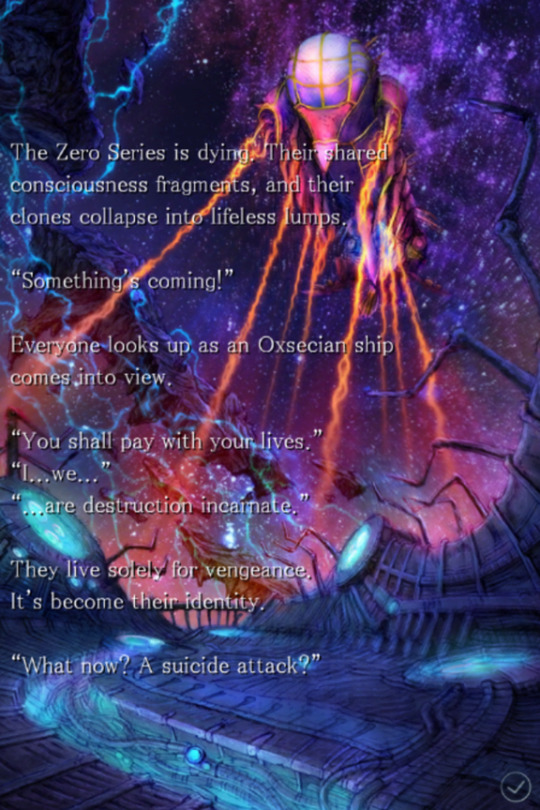
Things are coming to a head, now.
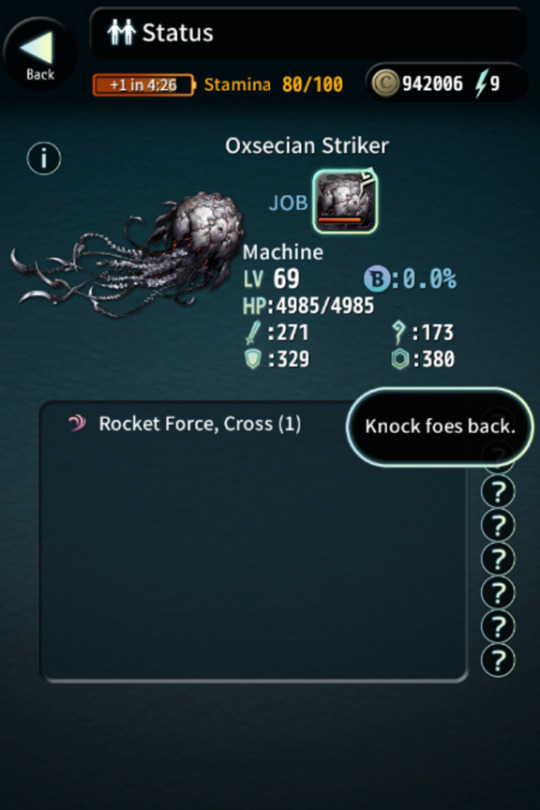
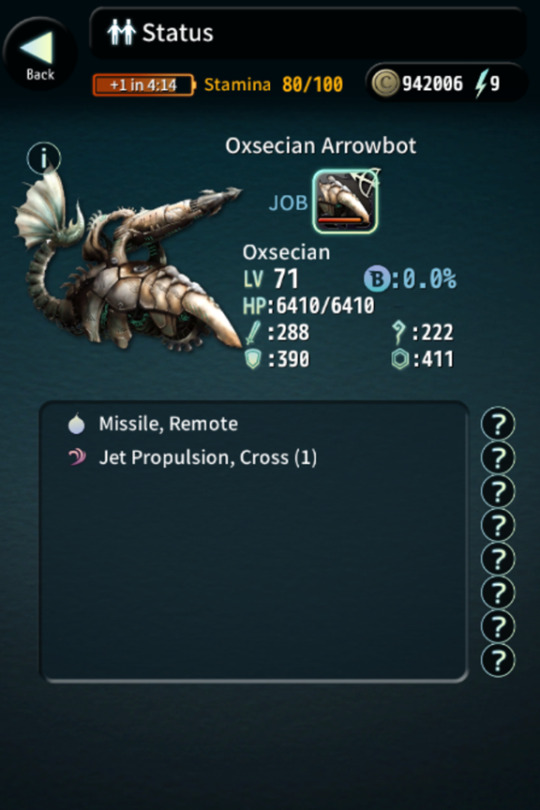
30-1 is five rounds of these two enemies. They aren't too out of the ordinary. The Oxsecian Striker’s Rocket Force move doesn’t do damage, just displaces your units.
30-2 The rancor that has festered in their souls for so long.
The Oxsecian ship unleashes its weapons en masse on Animata, intent on retribution.
This is the day they will finally purge themselves of the rancor that has festered in their souls for so long.
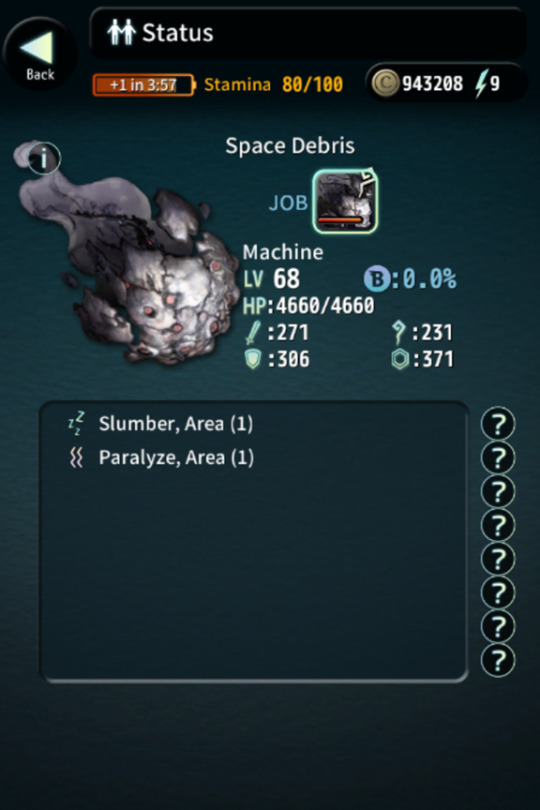
A new face among the two enemies seen in 30-1: sentient space junk! They appear in the second, fourth, and fifth battle alongside some other mooks. Take care of the Oxsecian enemies while hopefully staying out of range of the Space Debris’ status-inducers.
Of the two, sleep is less annoying, so it’s not a bad idea to bring someone with Panacea (at the very least, Palpa will have it, but there’s also have Eileen and Gatz or Sheena w/ Cleansing Caper), or even just Locomotion (Palpa again, but Bonna and Kana are notable for having it while also having Paralysis Ward. Kana’s A class so most people likely have her anyway).
Of course it’s a complete non-issue if you get rid of them first and/or stay out of the AoE, but it never hurts to be careful.
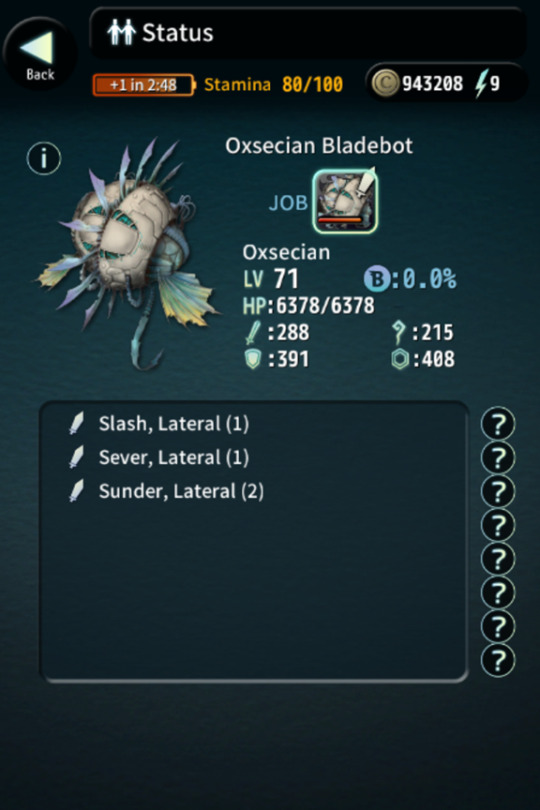
30-2 introduces this, the sword counterpart to the other.
30-3 The king does not budge.
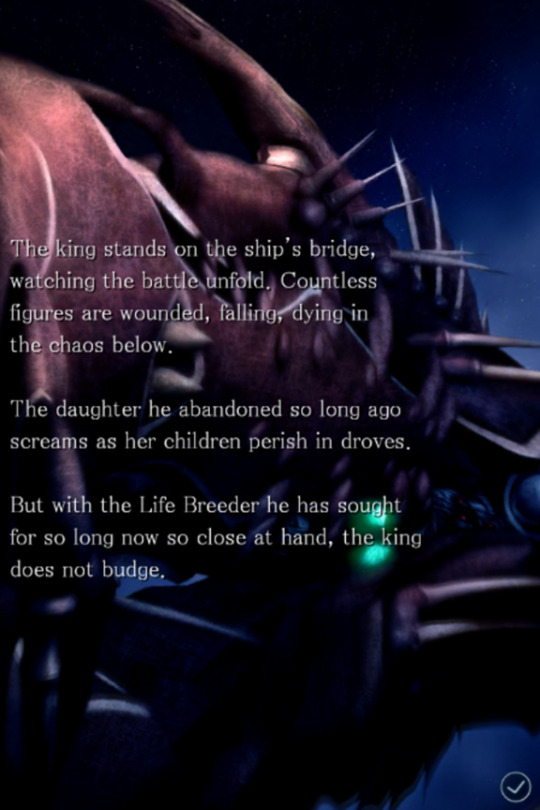
Three battles this time: Space Debris/Oxsecian Bladebots make up the first and third battles; latter is notable since there’s 10 Bladebots to deal with.
30-4 With a subtle, slithering movement.
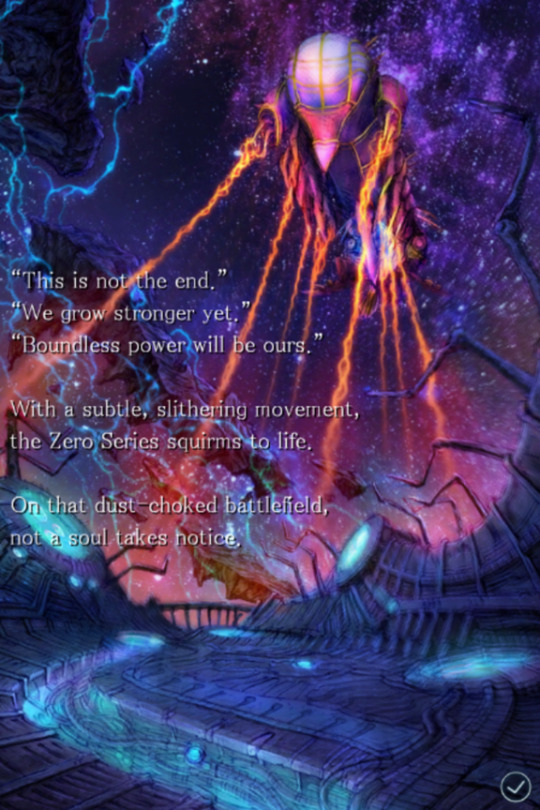



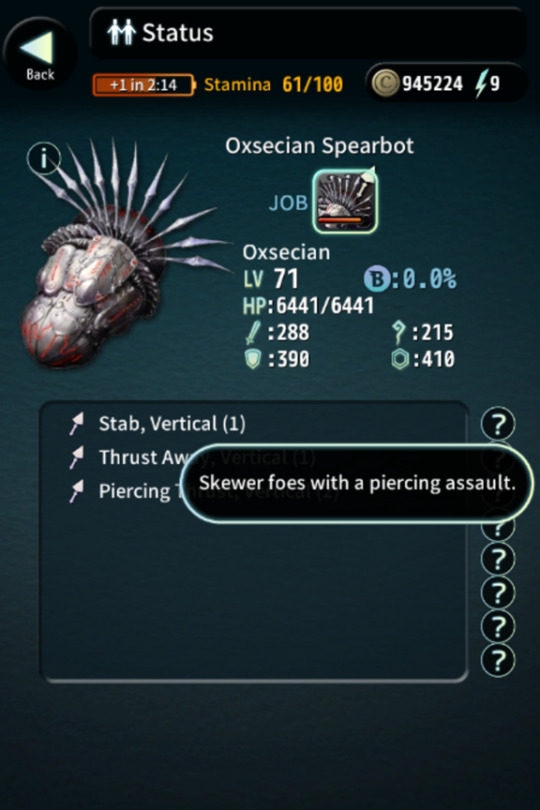
This introduces the Oxsecian Spearbot. Fairly self-explanatory.
There are no Space Debris in this stage; just Bladebots, Spearbots, and Strikers.
30-5 The sound of a massive explosion rips through the air.
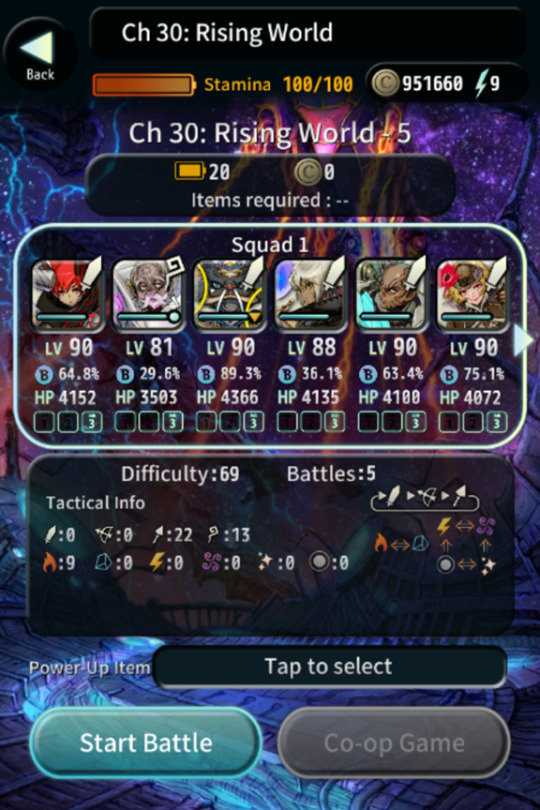
This battle is of spear-enemies, so if you’re not overleveled like my crew, arrows are better.
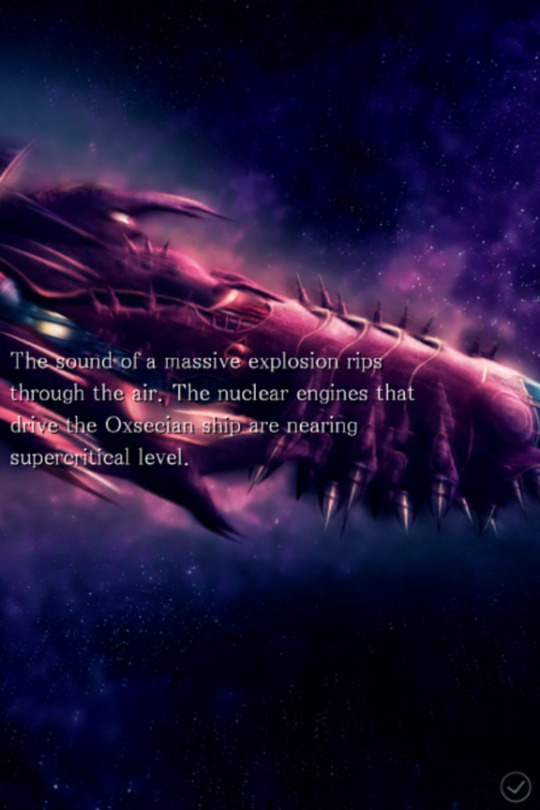
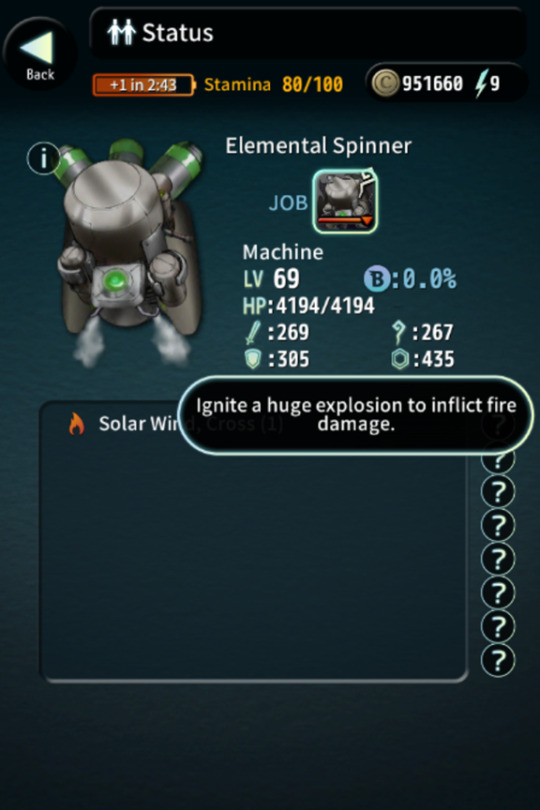
This enemy is introduced here, and I guess is notable because it has Solar Wind, the at-the-time strongest Fire elemental spell (at 3x damage). Its in a cross range, so I guess be aware.
30-6 Shield with Animata.
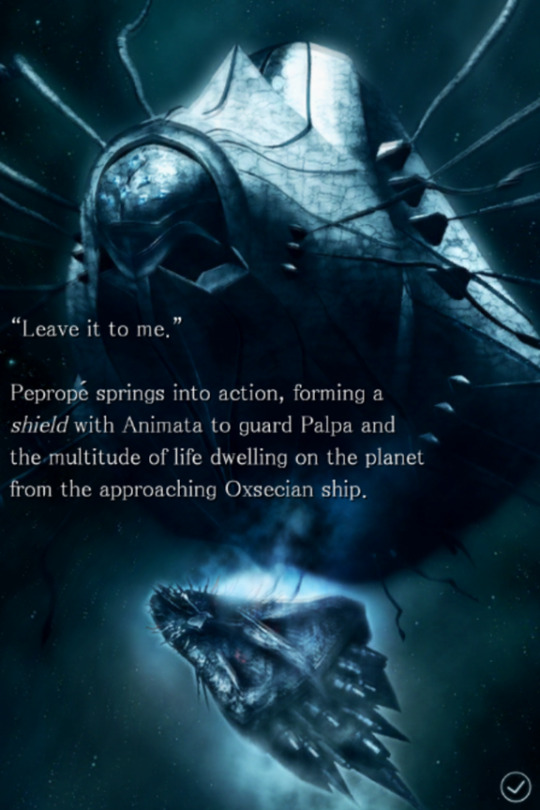
Four battles this time. There’s another new enemy: another Elemental Spinner, this time ice-typed, with Absolute Zero, Cross (1).
30-7 Trust in me, overworlders!
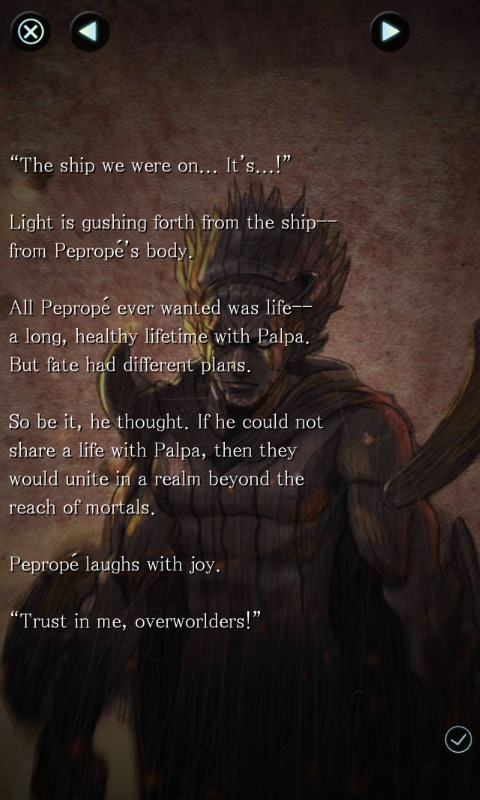
There aren’t any Elemental Spinners here; just fights against Oxsecians.
30-8 Their collective will is sublimated into radiant life.
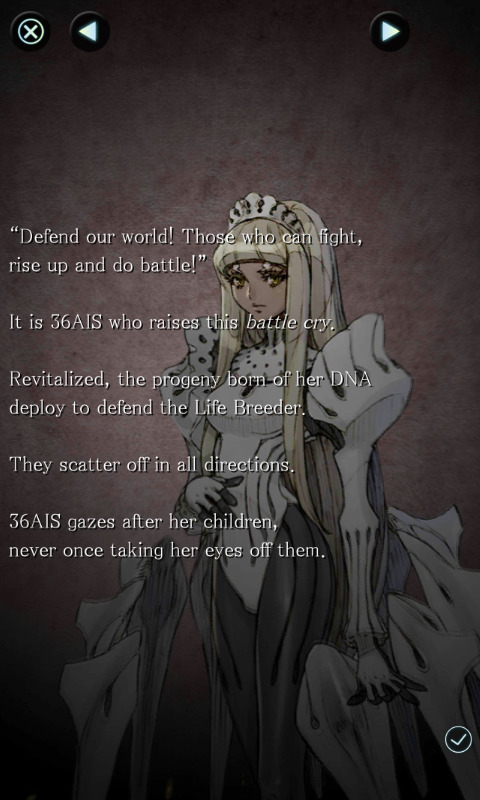
Their collective will is sublimated into radiant life that illuminates all.
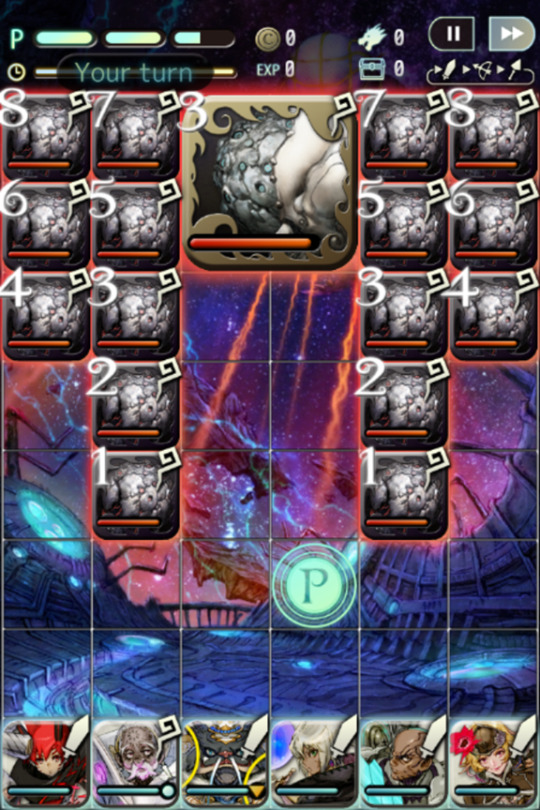
“That radiance, washing over you, becomes a source of newfound strength.”
Before the battle starts, you get the message above. What this does, as you may notice, is fill up the Powered Point gauge to near-full.
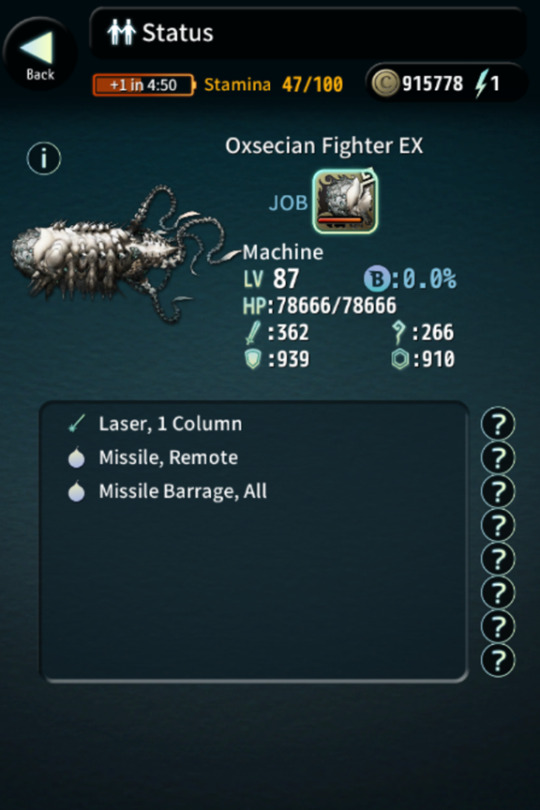
There’s only one battle in this stage; the boss is the Oxsecian Fighter EX (as noted by the 4x4 square), with a whopping 16 Oxsecian Strikers backing them up. For the most part, though, it’s not too bad: its moveset is really simplistic, with the only skill you have to be concerned about being Missile Barrage.
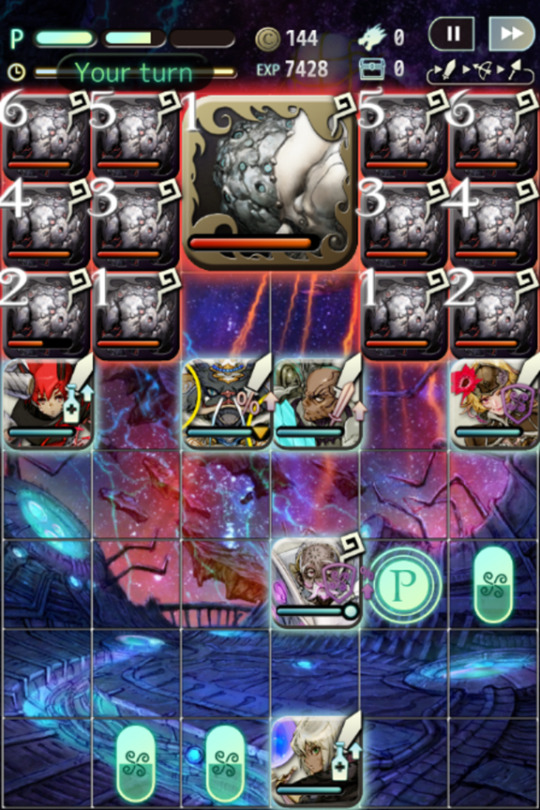
It helps that the mooks have a number of turns before they act, giving you time to pincer them and create some breathing room. They’re all staff, so no circle of carnage advantages. For a pack like this, you’d probably want at least one mage for their AoE attacks.
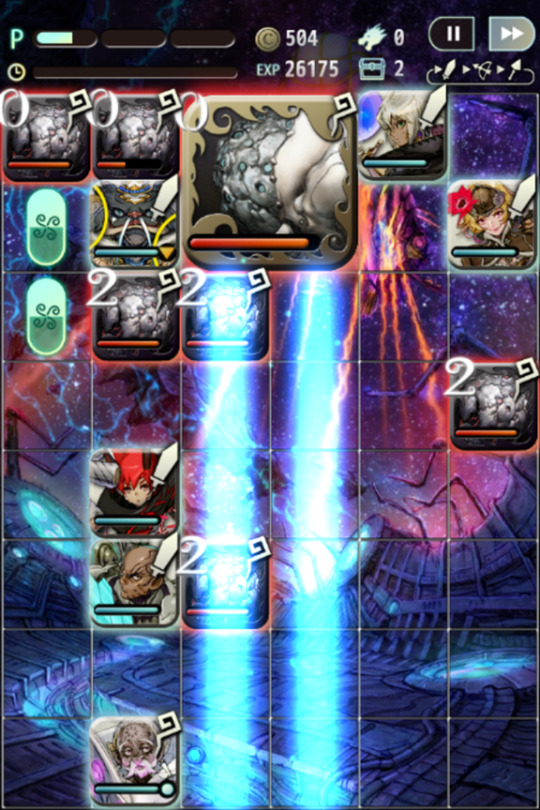
Its laser attack is column only, so just stay out of range.
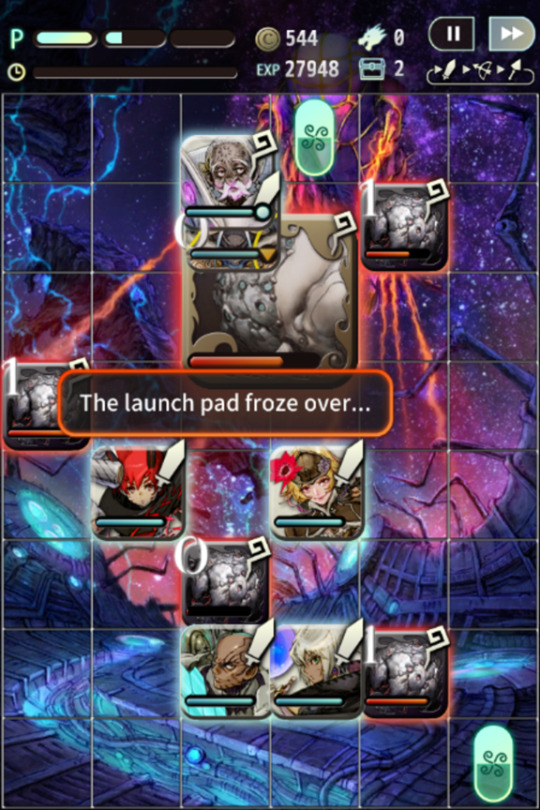
It will telegraph when it’s about to use Missile Barrage, saying sth among the lines of “Missile Launchers open”; you have a turn to prepare, heal, etc. If you bring anything that has an Ice attack, this will happen, making it lose its turn.
After that, it’s just a matter of chipping it down and any other Strikers it summons. Finally, it can drop Dark Matter and/or Mantle Helixes.
30-9 The power of will evokes a miracle.
The formidable will of the humanoids rouse an even greater power: the beasts that inhabit this world you once dubbed Planet Beastbait.
Humanoid and beast alike stand ready to confront the alien threat.
The resolve to defend their home--and the home of future generations--converges into one will, transcending ecosystems and the planet itself.
The will of countless creatures great and small converges into a single purpose: to protect the future.
As one, they raise their voices in a thunderous rallying cry to that future.
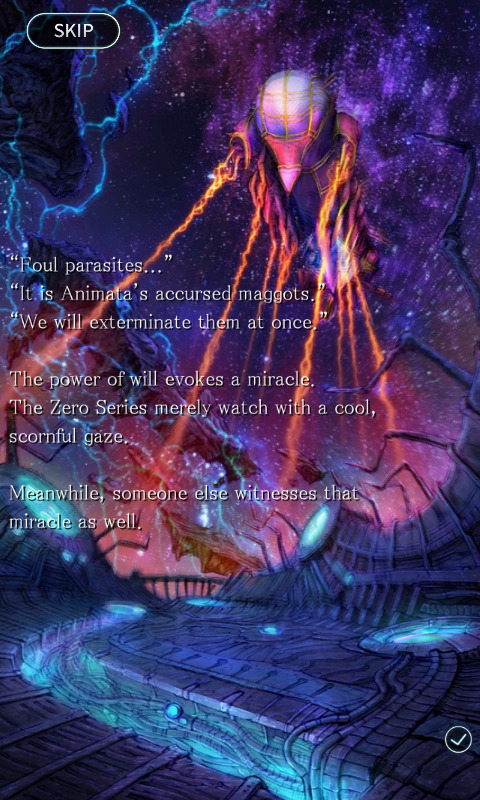
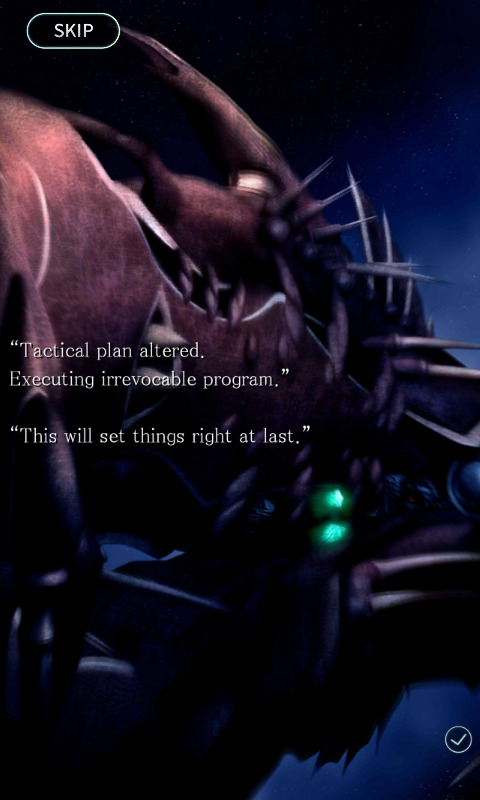
Hmm...
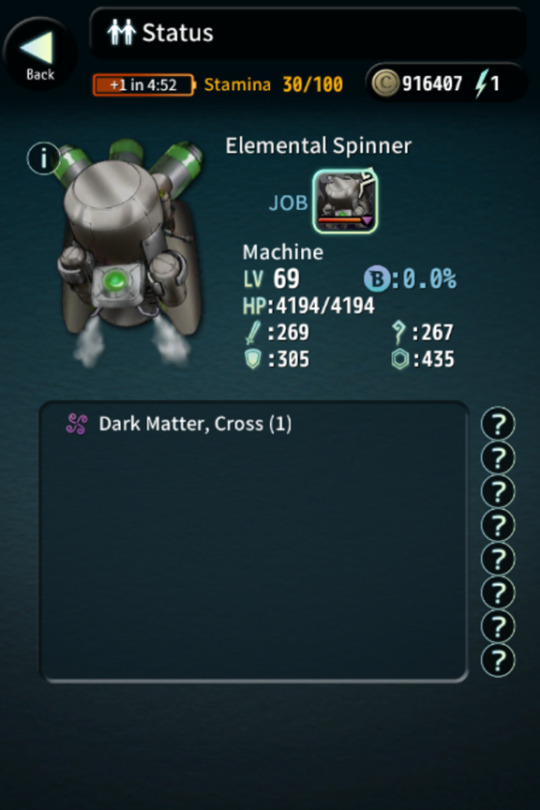
After that fight, 30-9 returns to the 5-battle stage. Another Elemental Spinner is introduced. Good thing there’s no elemental mixing and matching.
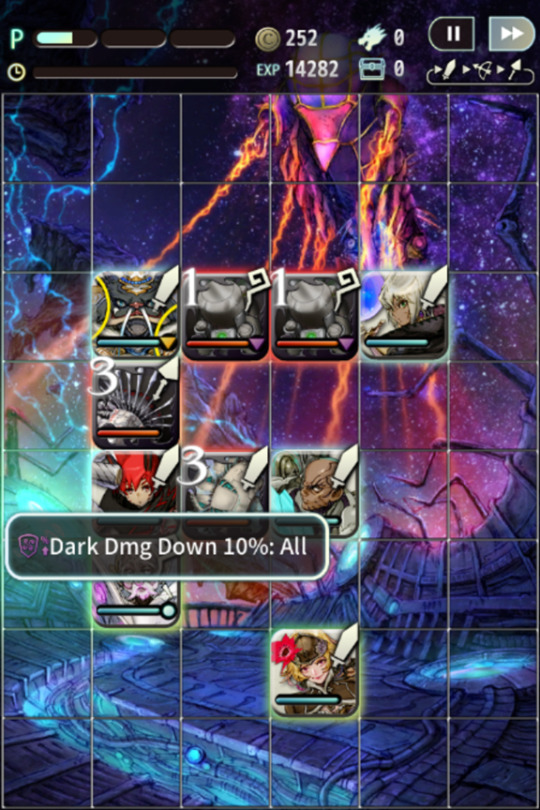
Ba’gunar was helpful for dealing with them, with both type advantage + summoning capsules. If you’re not like me and have great luck, managed to pull someone like Samatha or Jennish – even better.
As an aside, there’s a chance of nabbing a Demon’s Badge otomo from this stage. Its evolved forms eventually provide Death Ward, self – which has some niche uses, I guess!
30-10 AND SO WE RETURN TO ZERO!
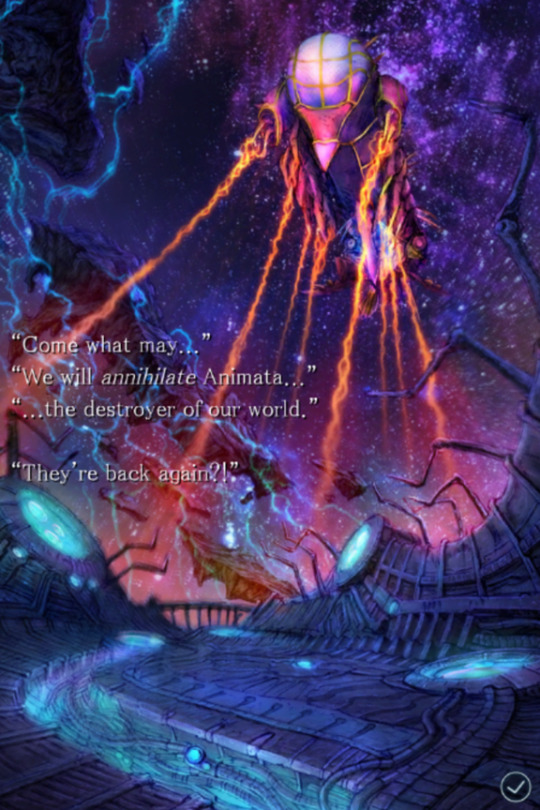
Everyone was too caught up in the battle to notice they vanished. But then, perhaps it isn’t a surprise they came back given what we’ve seen of them in previous chapters…
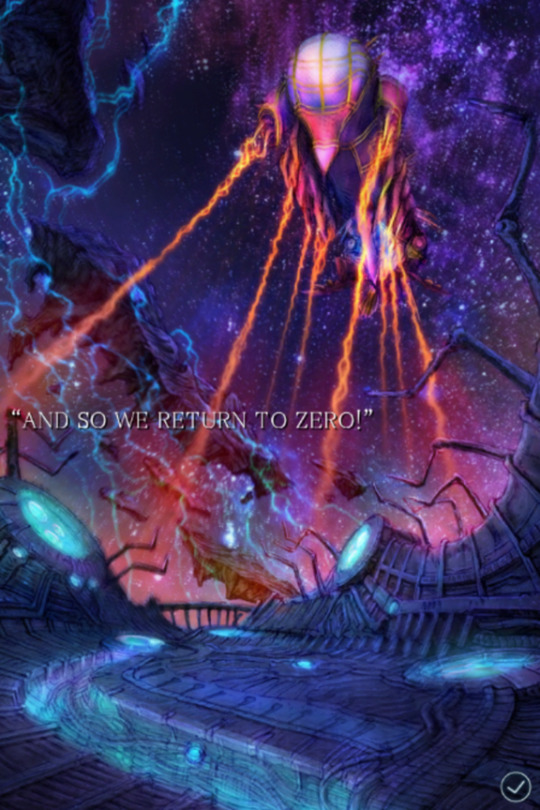
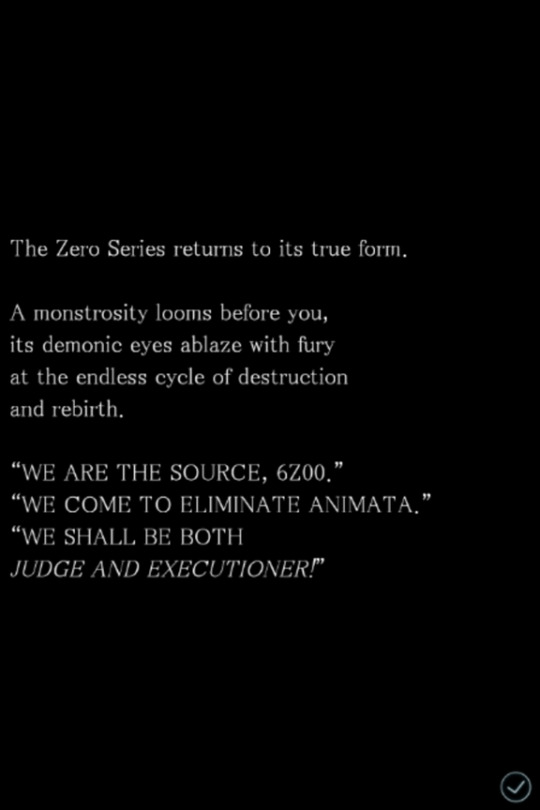
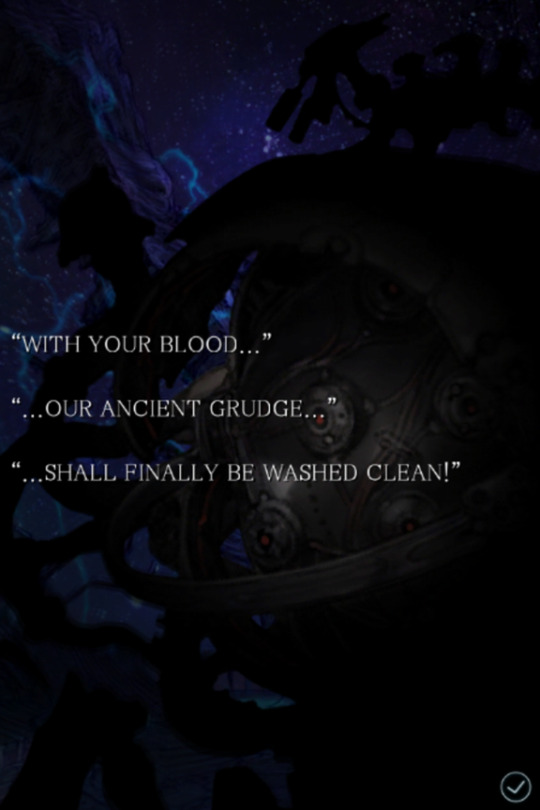
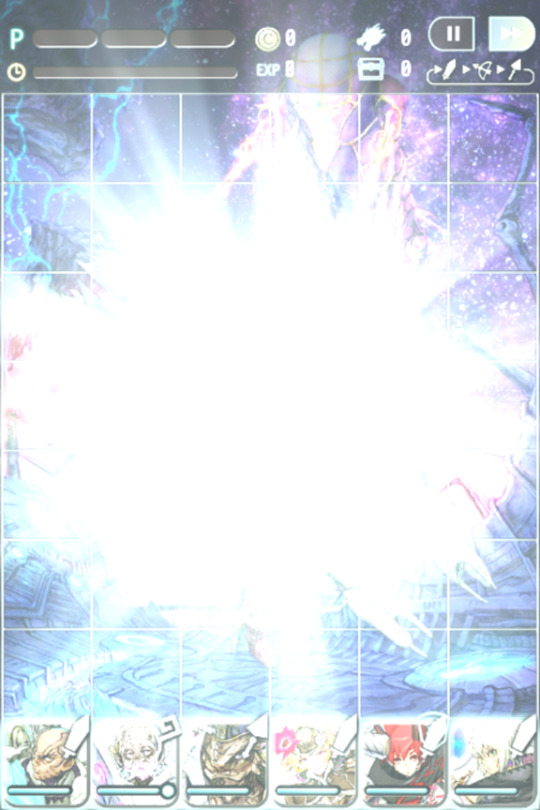
Before the battle even starts, we see each member of the Zero Series fuse together into…
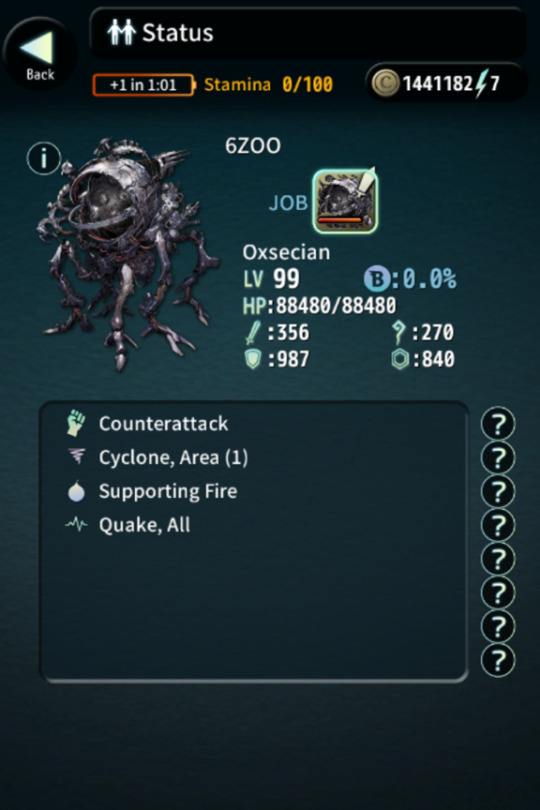
6ZOO. He’ll always start the battle with Cyclone, Area (1), which does damage and knocks units back. At level 99 with those stats, he’s pretty beefy.
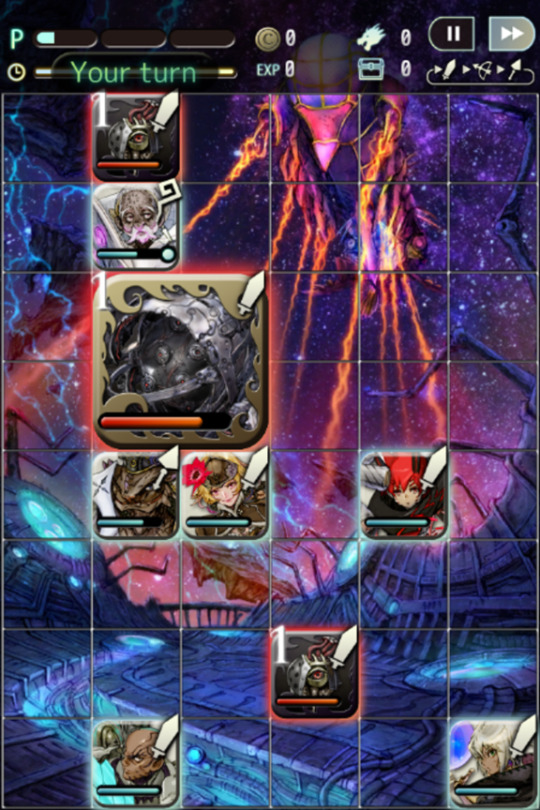
He has Counterattack, but it will always proc when pincered. He also summons two mooks too after using Cyclone; in fact, he follows a pattern of: Cyclone > summon two mooks matching its type > switch weapon. The weapon type switches from Sword (default) > Spear > Bow > Staff, then repeats.
The Staff form is notable because 6ZOO doesn’t summon anything, but will spend a turn preparing to use Quake, All. It’s one of the reasons I brought Gatz.
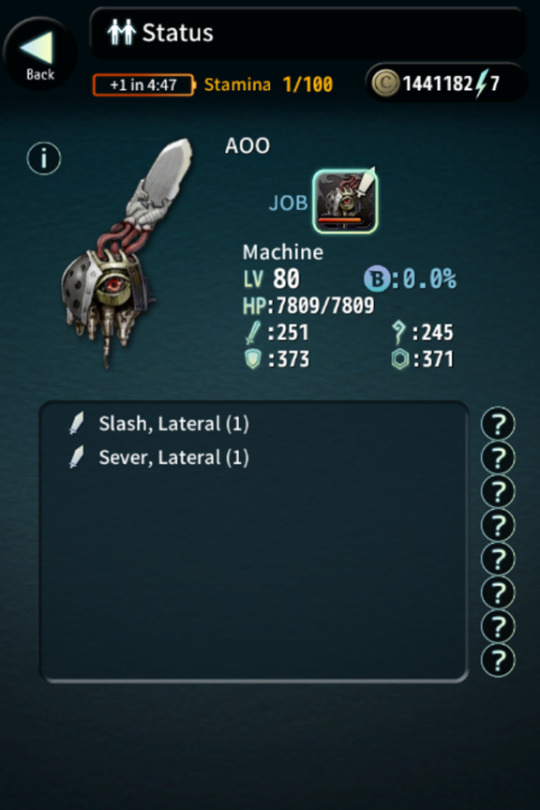
The mooks aren’t too bad, but their attacks can add up as 6ZOO beats your team down. As you clear them, take note: 6ZOO will use Supporting Fire whenever one of the mooks is pincered. Keeping health topped up is seriously important, and this is with a mainly B-class team that’s near his levels. (Fun fact for non-vets: levels used to be maxed out at 70.)
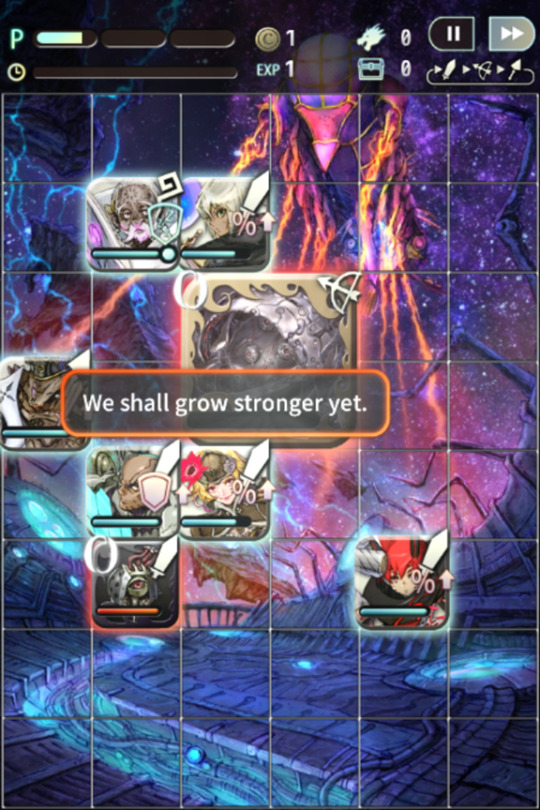
Once you wear it down, it says this…
Music (listen to this!): The World’s Awakening/Day of Reckoning
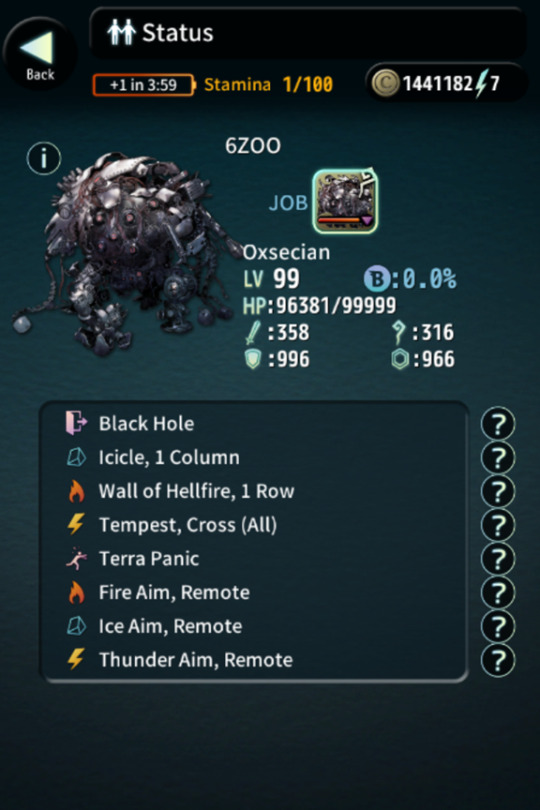
…and transforms again, recovering HP and becoming even more monstrous! This time around, it stays Staff-typed, but switches elements around. As it does, it not only summons corresponding Elemental Matchers, but also absorbs attacks of the same element.
Not a problem if you’re bringing a majority-physical team like I did, but…
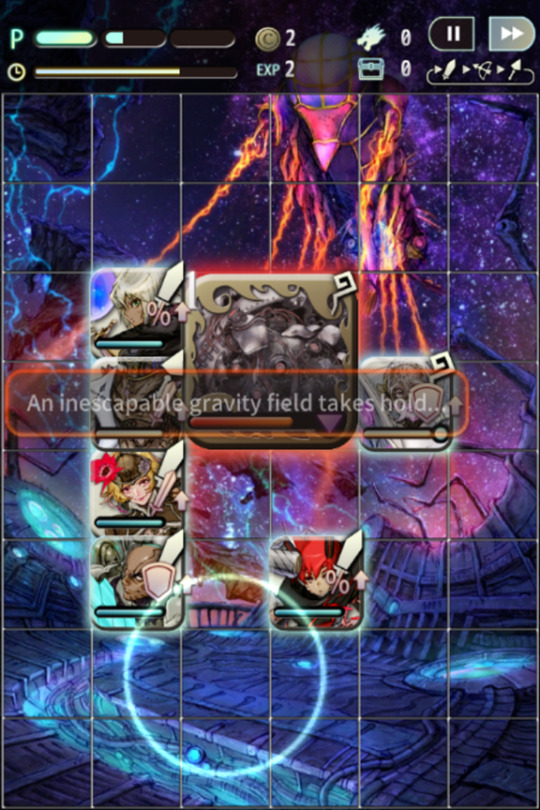
A few turns in, you’ll get this message. It’ll telegraph the big moves, then follow up w/ the corresponding elemental aim attack (except when its Dark-typed):
An inescapable gravity field takes hold… > Black Hole
Crackling bolts cross and spread outward… > Tempest (Cross)
An inferno blazes up on both sides… > Wall of Hellfire, 1 row
A band of frigid air descends… > Icicle, 1 column
Watching and waiting… > Terra Panic, All (occurs at ~25-30% HP)
Tempest and Icicle are explanatory: they’re strong elemental attacks. Wall of Hellfire creates flames on the rows 6ZOO is on – it’s a really damaging stage hazard, though mercifully it only lasts a couple turns and can kill off the mooks. Black Hole transports two random units away for a few turns.
Terra Panic is its big move; it affects everyone with every status effect except Ice/Shadowbind and the Solar/Lunar related ones. As a reminder:
Poison: damages units for a few turns. (not bad normally because it never kills your units, but could potentially help the boss/mooks)
Sleep: units don’t act and can’t be moved for a few turns or until they take damage. (the least dangerous, but iirc they can still be shifted)
Paralysis: unit don’t act and can’t be moved for a few turns. (You can still shift them away, though)
Demoralize: unit’s physical attack and skill proc rate drops to 0 for a few turns; buffs still proc, while demoralized units can still use skills w/ a Powered Point (though physical attacks will hit for peanuts)
Confusion: unit moves around randomly, cannot be controlled, act in chains, or be used to pincer. (This one is pretty bad because your unit is useless until it wears off, and they can put themselves in range of attacks or run through Wall of Hellfire if it’s up)
Petrification: unit turns to stone, cannot be controlled, and can’t be shifted by other units. (IMO the worst status effect because it pretty much never wears off; your units get petrified for 99 turns! By then the battle is over, either with your units dead or the boss dead.)
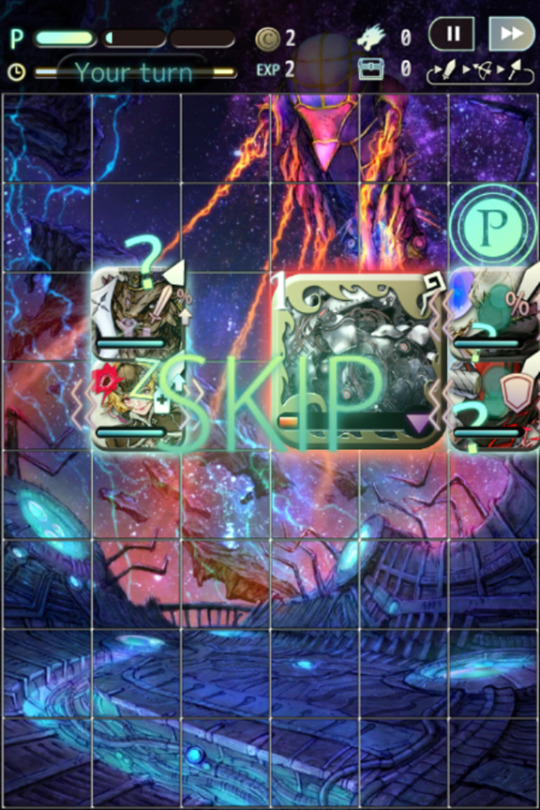
This is why it’s good to bring along a Remedy character or two. I had Gatz (who has Sleep Guard, Adjacent and Panacea by J3) but Bonna comes to mind because her J1/2 teach skills that cure Petrification and Paralysis while she herself gets Petrification/Paralysis Ward, but again, there’s Palpa. Just hope she doesn’t get petrified…
I was lucky to not get petrified, but this was pretty bad, too. Everyone was a sitting duck while Sorman and Zan were off who-knows-where after getting Black Holed.
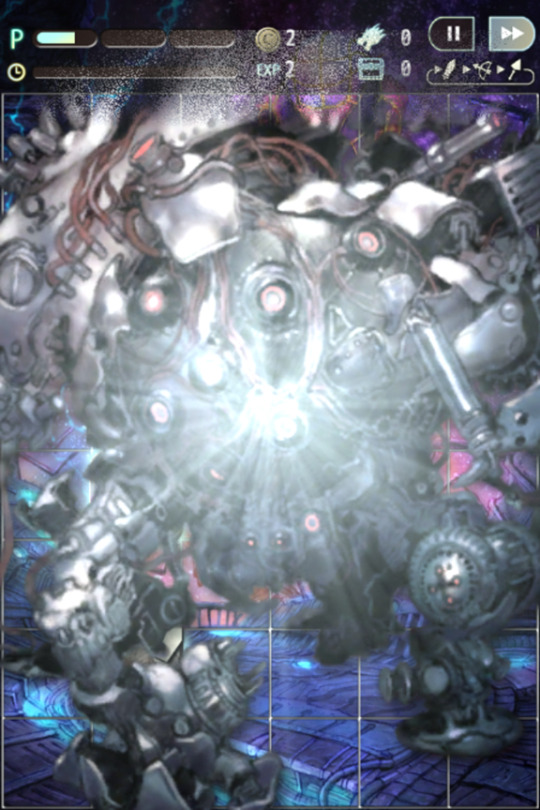
Thankfully after that, things are fairly smooth sailing.
Now, onto the epilogue…
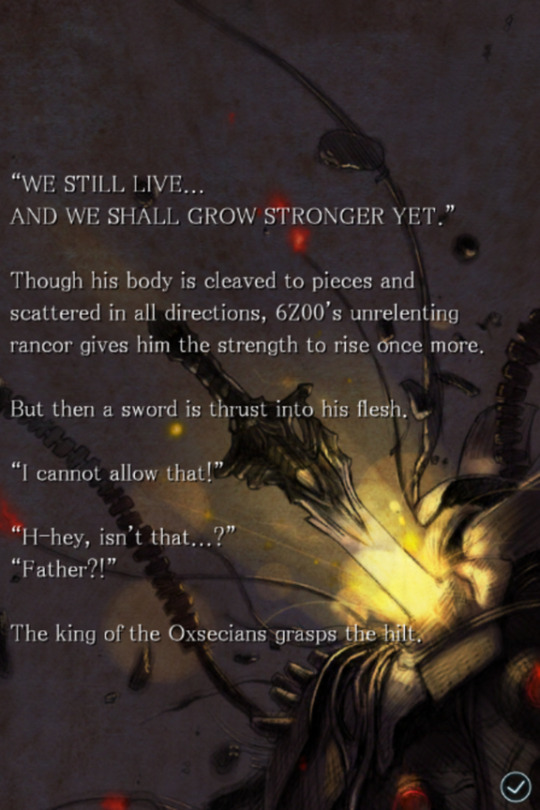
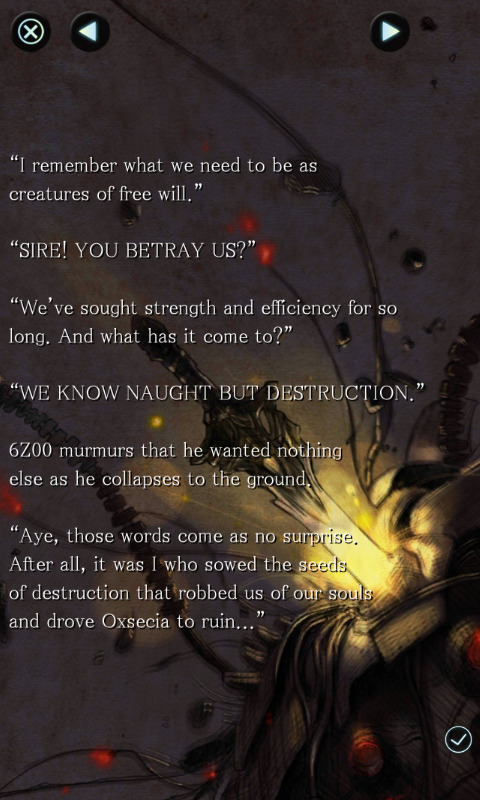
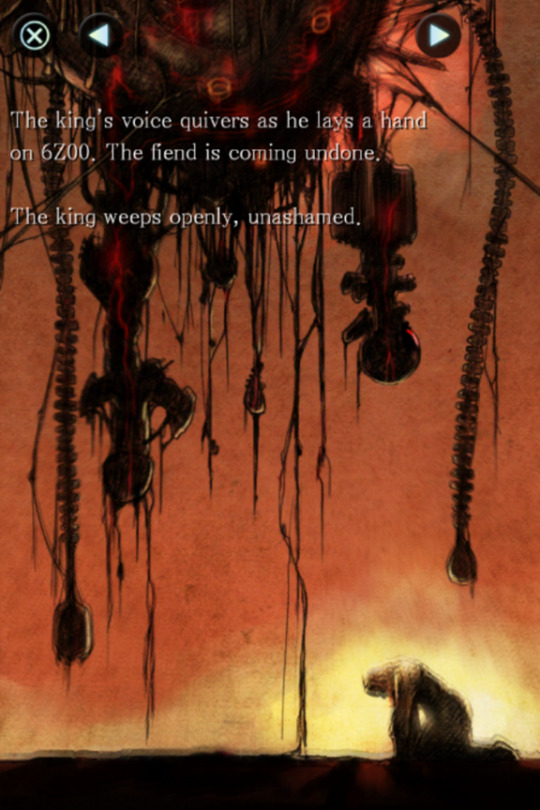
“What is happening?”
“What are we to do?”
“I do not understand.”
“This is no fault of your own. It is simply that I have chosen a brighter future. Forgive me.”
“Father…”
A strange sound emanates from the Oxsecian ship.
“Sire, what have you done?”
It was 6ZOO who set the Oxsecian Ship on its suicidal course.
He sought complete and utter destruction, even if it meant his own end. He desired nothing more and felt no attachment to life.
He was the perfect weapon, destruction incarnate. This was the mission assigned him by his king.
But the king had realized the error of his ways.
“I have changed the ship’s course.”
“WH… WHERE TO?”
“Is there somewhere you wish to go?”
6ZOO does not answer. He has collapsed into a heap of inorganic material.
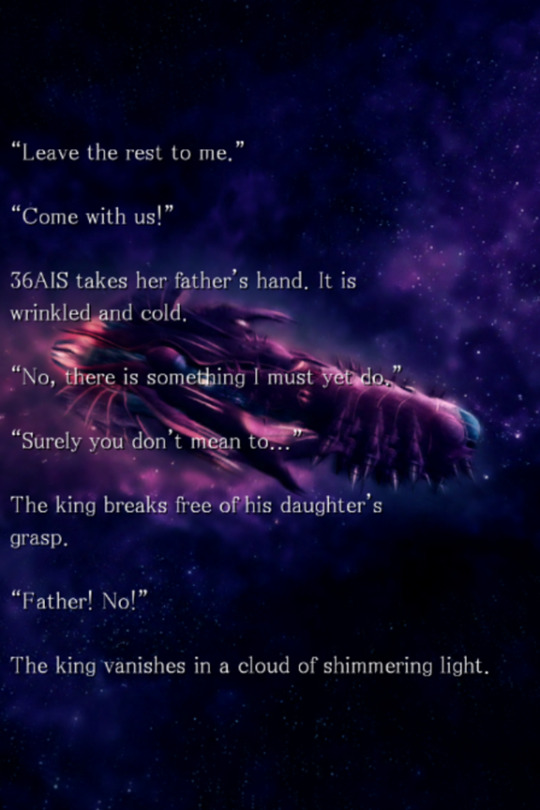
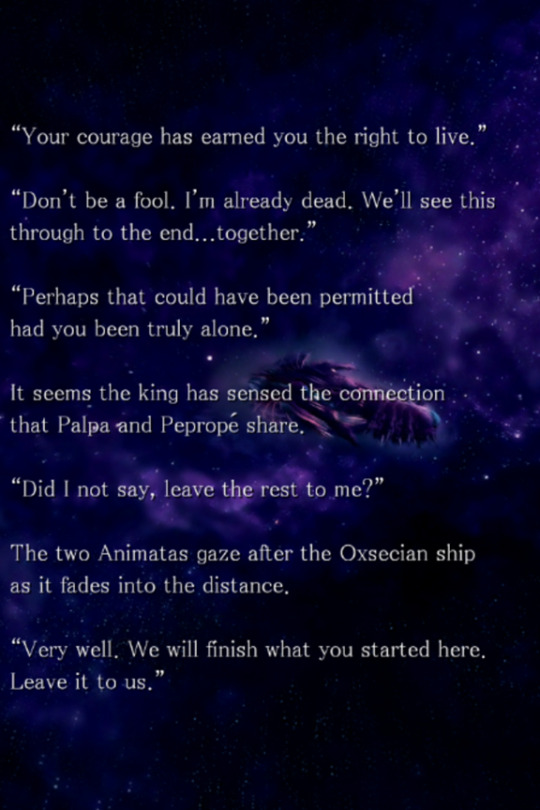
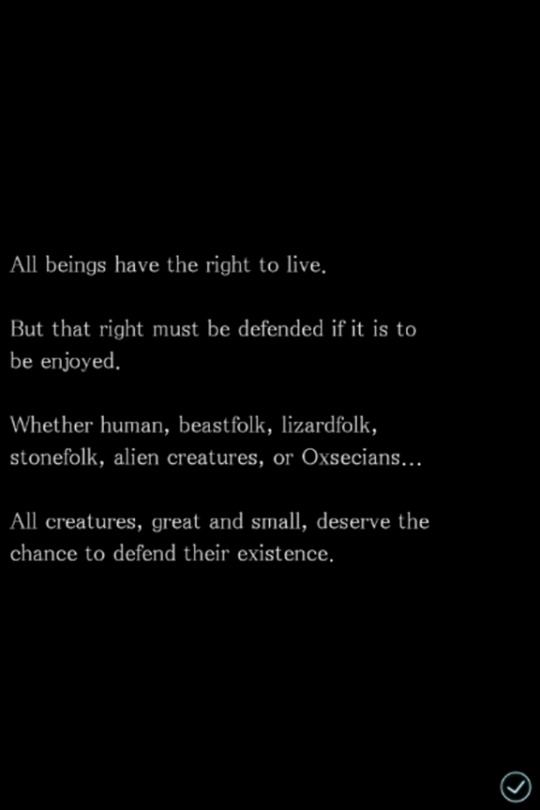
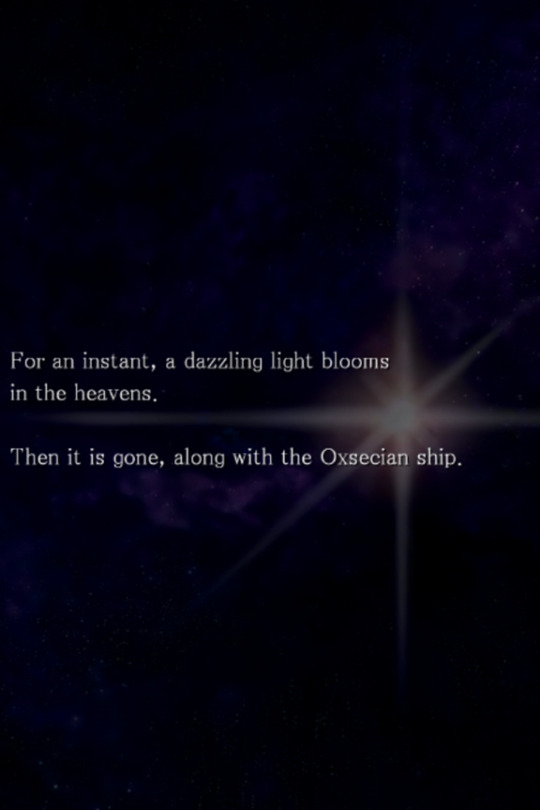
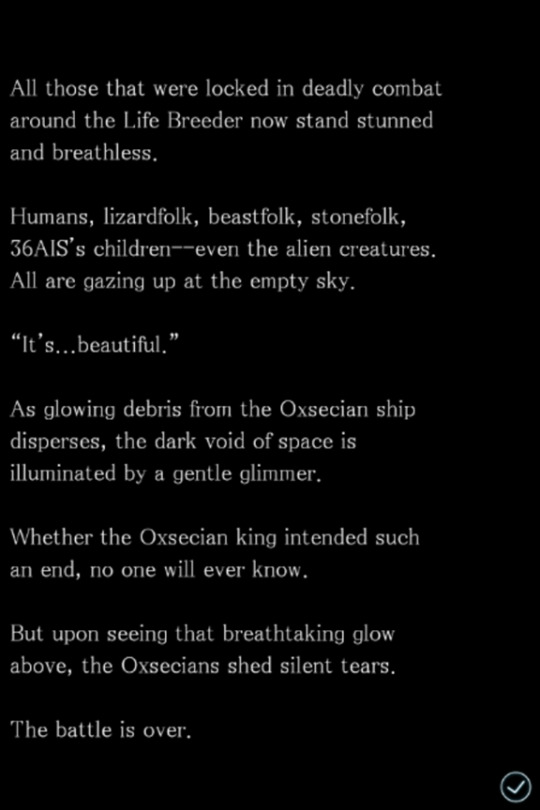
Animata is a massive technological life form. Humans, lizardfolk, beastfolk, stonefolk, and the children of the Oxsecians dwell within her.
All of these are species created from DNA plundered by Animata in her travels. Each has a home world somewhere in the vast universe.
As anyone might do, they seek out their roots to discover their origins.
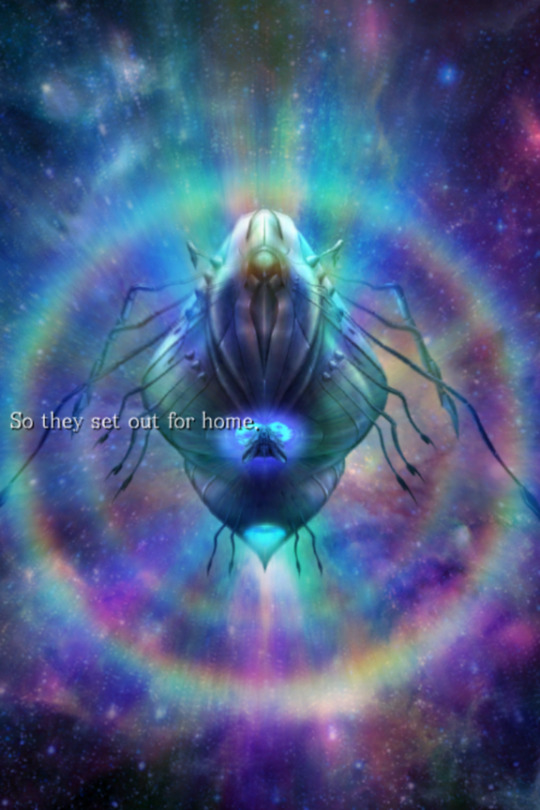
There’s something really poignant about that simple message, accompanied by that backdrop.
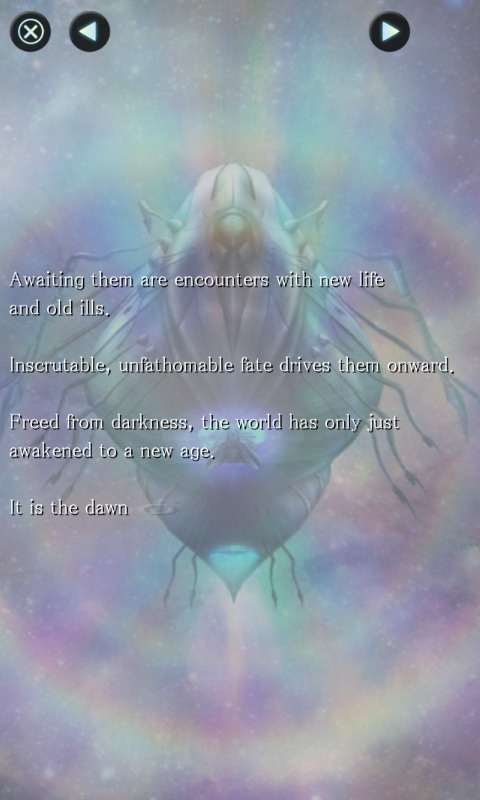
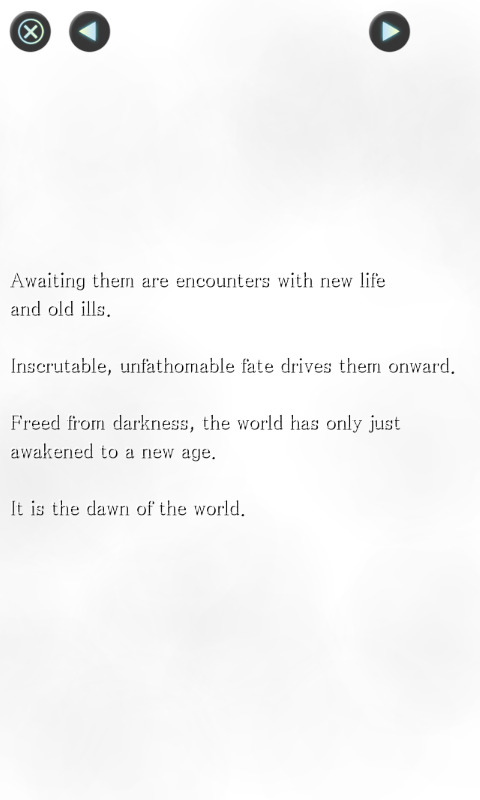

It’s been a long time coming, hasn’t it? With this, part one of Terra Battle is finally, finally complete. Though this may be done, there’s still more left to do. I’ll be putting up the table of contents for part one, and from there on it’s just catching up to my story progress in-game.
Finally: that final boss theme tho, god bless Uematsu. Fantastic track, in a game with great music. I actually remember getting some chills when I played through 30-10.
2 notes
·
View notes
Text
Some thoughts on my last Gamefly rental, Song of Memories.
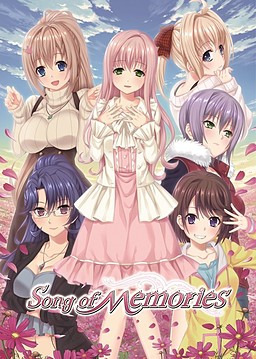
It did not get off to a good start from me. First, I was kind of tired when I decided to start playing. And you know that ‘MC’s best friend whose always has bad romantic luck that people don’t like and acts like a horndog’ trope? Yeah, it starts off with one of them. It thankfully moves past that part fairly quickly, but I learned my lesson from when I played Our World Is Ended, which I started playing while I had a headache and had a bad time for a while, so I held off on getting back to it when I wasn’t tired.
There is a decent amount of fanservice, though it’s spaced out and actually less obnoxious than I was expecting, but the game does unfortunately make the mistake of putting it in a couple scenes that are supposed to be more serious, hurting the mood, in my opinion(thankfully not many).
Though it’s not even close to the point of being unable to tell what’s going on, there’s quite a lot of text goofs, like a couple naming inconsistencies, and typos that I think needed a second pass to clear up. Seems like third lines in dialogue boxes had a bad habit of having the first letter cut off for some reason.
Oh, and one heroine, Fuuka, is the MC’s adopted/non-blooded-related sister.
Decided to get my more negative thoughts I had on it out of the way first. If that hasn’t made you decided to skip it, good, since there is plenty more to it than that.
The game uses something like Live2D and a unique ‘Emote’ system for the dialogue and, surprisingly, CGs, and actually does something neat with it: at some points in both, they have the characters do several different things, such as change expressions on the fly or look at speaking characters instead of looking forward the whole time, and it actually looks like it’s done pretty naturally most of the time to me. A few nameless characters, and specific enemies, don’t get this full treatment, just the standard ‘looks like they’re breathing’ effect. This might make more sense to see than have described to you, though. If you’ve played Yuzusoft VNs, they do something similar, but are still just static images. I hope this system gets used again in another VN.
Speaking of the CGs, the MC, default name Minato Kamishiro, is drawn in them without visible eyes(the way he’s shown is like a generic character with his eyes meant to be hidden under his hair), or sometimes his face is cut off by the screen, and I think that hurts the impact some of the CGs he’s in, since it makes him much less expressive compared to the others.
A fun extra that you get after getting a character’s Normal or True End is letting you mess around with the character portraits and the various poses/emotions they have that lets you see how expressive they are.
There’s a very handy flowchart that you can use to jump around to pretty much any point in the story you’ve seen before, which makes getting all the endings easier, as well as a Trophy that requires you to pick every dialogue choice, which can get monotonous, at times, especially all of the ones for D4U.
At one point, a battle system is introduced, using virtual idols to fight enemies(just roll with it; it sort of makes sense later), which is pretty much just a very simple rhythm game(though higher tier moves are more complicated). They can be skipped if you want, and you still gain EXP(expect for certain fights later on). There’s only one battle before the route split(except if you’re going for Akira’s), though. Its mostly done fine, though there’s no HP bar for enemies(only the MC has visible HP), and a few battles just have static art that doesn’t react to damage, which made me think I was doing something wrong at first. If they decide to have something like this again, I hope they expand it to look more fleshed out, like it’s from a normal RPG game.
The first half of the game is the ‘Joint(Common) Route’, where you work on getting onto a specific heroine’s path. After a certain point, the second half, and a specific character’s route, begins. It’s probably best to do one full blind run before using a guide. There is a Bad End for the Joint Route, but it’s pretty hard to get it accidentally.
If you’ve seen the game’s actual box art, which isn’t what's shown above, you know it has quite a different tone. Though the official descriptions hint at it, I’ll put stuff about the second half’s events under a Readmore.
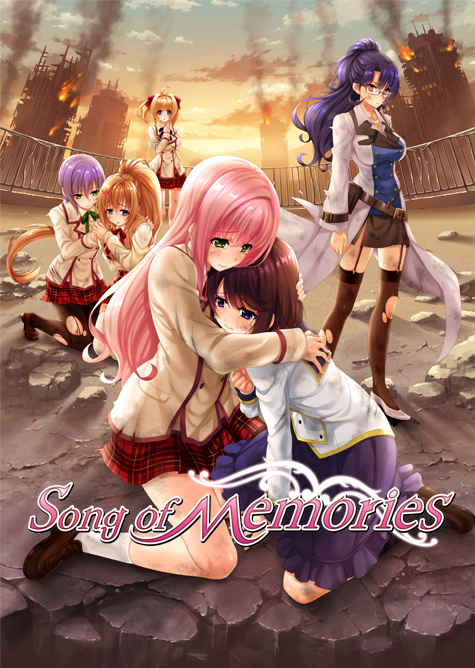
On a certain day, which you’ll probably be able to guess, someone with the X-Virus starts attacking people, and chaos ensues. There’s even a second opening made for this section, to help set the mood.
The shift in tone is a bit jarring, and even though I knew it was about to happen, it actually startled me for a second, but what happens is foreshadowed at a few points during the game. I think this is where the story starts picking up more, too.
Since this is the point where the story splits into Character Routes, the events of each, for the most part, are all pretty different from each other, though some specific details and events are a constant through each.
For the heroines, I liked Yuno, Satsuki and Natsume’s routes the most, and though I didn’t hate it or her, I liked Fuuka’s route the least, for the reasons mentioned above. Kanon’s seems like the one that’s probably supposed to be ‘official’, since she’s very important to the story’s events, is front and center in the official art, and gives the most background information on what caused the outbreak.
Makoto has a route, too, where he actually acts like a good friend instead of his usual self in the end, though it stops before the outbreak.
This part of the story, like Devil Survivor that has a similar premise, is good at showing people’s possible behavior changing, and losing their humanity and rational thinking during such a lockdown, though I feel the former does it better, overall. Themes like the mobs of survivors possibly being scarier than the monsters is something shared between the two, I think.
Speaking of, the ‘horndog best friend’ I mentioned above, Makoto, gets changed by the events that kickstart the story’s second half pretty differently depending on the route. In one, I’d say he redeems himself in my eyes, while in another, he goes way off the deep end. I can see what drove him to become like that, but it and something else he almost lets happen are inexcusable.
At certain points in the section, you’ll have to pick where to travel on a map, one section at a time, and it’s possible for random battles to happen here. The rate increases on repeated playthroughs.
...not to get too topical, but due to current events, some parts where characters that are known to be infected with the X-Virus go out to where some groups of people are getting relief supplies just kind of bugged me. ^^;
I was skeptical of it first because of previews, but this was actually worth taking the chance on playing, some annoying parts mentioned above notwithstanding. Each route is also fairly long(some shorter or longer than others). I want to see them use that Emote system in another visual novel; it really helps add more life to characters during dialogue scenes.
I did use a guide, but I’d recommend trying it mostly blind unless you get stuck, since it’s not spoiler-free.
Next game being sent is: Teenage Mutant Ninja Turtles: Mutants in Manhattan.
0 notes
Text
Mostly vidya ramblings - Part 3A cont. . .
Part 1 of Ze Finalists
The final 2 of 2020.

Deus Ex: Mankind Divided (PS4 -- also on XB1, Steam, GOG, Linux, macOS)
I’d put this off for way longer than I should’ve, but end of 2020 seems apropos given that its *the other* cyberpunk themed game, and at least this one isn’t fundamentally broken. Say what you will about the long standing jank in the DX series, or that Square Enix hacked bits off the game for a convoluted and entirely shitty season pass upsell, or that the augmented apartheid metaphor upon which the game’s fiction hinges is stupid, or that MD lacks a 3rd act and will likely never get a sequel, etc. What you get here is a great game, in certain respects inferior to Human Revolution (one of my favorite titles in recent memory), and in others quite different and possibly the better entry.
Look, I’m just glad immersive sims are still a thing and though they’ve always kinda reviewed well but sold like shit, they’re still in somewhat decent health. I’m not fan of the DX series as a whole, but Human Revolution felt special when it came out in 2011, as a near perfect incorporation of old yet solid design principles but reinvigorated with a new sense of purpose and polish. It’s the rare soft reboot / much delayed new entry / prequel that does its originators justice while being a supremely confident game in and of itself.
What strikes you when you try to play the older DX games (recently tried but gave up half way through, using the Give Me Deus Ex mod), is how much Eidos Montreal’s efforts feel like the old games, but with most of the niggles ironed out, making for a far more approachable experience. In fact, they could’ve perhaps gone even further in sticking with the depth and complexity of the OGs, but then I’m not sure the game would be as fun. If say, Jensen’s ability to use weapons should were determined by his character stats, I think that would make the game insufferable, but the first game was definitely more of a CRPG than anything else.
What I mean to say is that I found MD ridiculously easy, even on the 2nd hardest difficulty, because if you play stealthily (I maintain that this is the so called “intended” approach), then none of the enemies pose a challenge. If you’re thorough about hacking, collecting things, doing side quests, conserving supplies, then you end up being a walking NPC vendor yourself; Praxis and resources overflowing from your person. This is compounded I think by the level design which is superb, but again, far too eager to make this a mainstream AAA experience, so there’s one too many ways to progress and you’re never truly locked out (unless of course you go out of your way to screw your save file over).
As Yahtzee so succinctly put it (much of this review is cribbing from his videos), you’re not so much roleplaying a character by making tough choices as was sort of the case with the original game, but merely picking what’s most expedient to progress beyond a challenge, and then if you so choose, going out of your way to hoover up the other loot and exp when and if it strikes your fancy. There was one Witcher 2-esque decision the game forces on you in the late game, along with a few others which are less consequential, and I appreciated that kind of explicit branching. But really, the game lets you have your cake and eat it in as many ways as you so choose, is what I’m saying, which removes the necessity for repeat playthroughs (this can be a good or bad thing depending on your free time and personality) and again, weakens the roleplaying roots of the series somewhat.
Still, well worth a play. Absolutely so if you’re a fan of the prior DX games or other immersive sims / ARPG stealth hybrids like Dishonored, Prey 2017, the Elder Scrolls / Fallout games, etc.
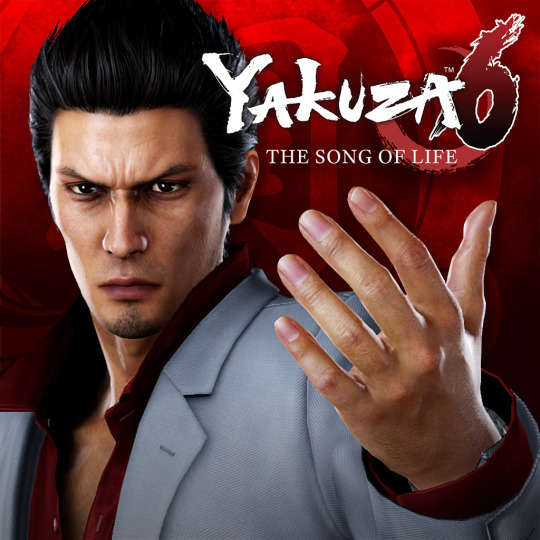
Yakuza 6: The Song of Life (PS4 -- also coming to Steam & Xbox)
I’m super glad the Yakuza series is blowing up, though I suspect largely in part due to the memes with maybe a huge proportion not having actually played the games themselves. It’s one of the rare games that both lends itself to great passive consumption material (all you kids with your Twitch or those who consume traditional YouTube LPs), and are also a blast to play yourself.
I’ve been playing these in a sort of Western release order, that is: watching the 2BFP LP of Yakuza 0, then doing Kiwami 1 and 2 for myself, and now this (and I also watched their Y4 LP ages ago). You could pretty much go into any entry point and be fine, what with the self-contained stories and generous flashback movies, and from what I can gather fans weren’t exactly super impressed with Kiryuu’s send off here (even I could sense that something was off and it seems most agree Y5 is probably the most fitting end to his arc, with 6 being a kind of meandering epilogue not unlike Toy Story 4 I guess?). But, judged on its own merits and not as a culmination to the Dragon of Dojima’s tenure as RGG’s main protagonist, this is a very solid Yakuza title.
The substories are every bit as good as the best in the series. What was lost in fighting styles, equippable weapons, explorable environs, or mini games is made up for with what has actually remained. The celebrity cameos are well acted. The big plot turn is every bit as dumb and inconsequential as you’d come to expect. Kiryuu still hasn’t aged a day despite everyone calling him an ossan and really? Dude is in his late 40s. If this is truly representative of Japan’s ageist culture then that is just... not good.
Anyway, Onomichi is great! The baseball substory wasn’t bad! The purportedly downgraded Hostesses were actually quite lovable! The Haruto babysitting section is every bit as bad as they say, but thankfully its short. Live Chat was excellent (and you can totally see the liberal ideas/asset reuse in Kiwami 2 where the photo shoot is basically just a rebrand). Clan Creator is a complete waste of time and I’m glad Y7 seemingly dropped it for good. The Dragon Engine’s first incarnation here is rough, esp. on a base PS4, but it’s fine. This game is like what, $10 now at regular price? And likely going to Game Pass for free? Do eeeeet.
0 notes
Text
Dragon's Dogma, Open World Gaming, and a Fool’s Errand

Open world games just really aren’t for me. This is something I started to finally realize during my playthrough of Breath of the Wild. Tying the do-what-you-feel approach to a series I’ve enjoyed as much as Zelda seems like it would be the magic formula to allow me to finally understand the major appeal of these types of games. Sadly, that did not happen. It was an enjoyable enough experience thanks to its leanings on classic Zelda mechanics and some more modern action game tropes, but I just did not care very much about exploring the world at large. Unlike games such as Skyrim, which have huge worlds filled mostly with empty landscapes, at least Breath of the Wild had stuff in it. There were tons of people, lots of collecty things to pick up for obligatory crafting, horses that still can’t compare to Shadow of the Colossus’ Agro more than a decade later. I cared about none of it. Everything I did in that game was with the singular purpose of beating it so I could say I did. I should have learned my lesson.
Fast forward several months and I’d begun to itch for a new fantasy adventure. There are more types of these games than I could ever play, so there was some care taken to ensure that I chose wisely. Reviews, game play samples, wiki entries all helped lead me to choose that next game. That’s why Dragon’s Dogma: Dark Arisen now takes up a substantial amount of space on my hard drive. On the surface, it was exactly what I was looking for. You can customize your character to a large degree. It has fantastic animations that feel responsive without being finicky or making the combat too easy. There’s still weight to your actions, so you can’t Bayonetta your way out of trouble or anything, but it is much faster than the From Software games of the world. So, perfect then. Fantasy hole filled.
Dragon’s Dogma is an open world done very poorly. The point of the game, at its most basic, is that you have to kill the dragon that stole your heart (which sounds suspiciously similar to the 1996 film Dragon Heart, but sorta kinda reversed). Having your heart stolen somehow makes you an Arisen rather than spelling your instant and everlasting death. Being Arisen means it is your destiny to kill the dragon to reclaim your heart. There’s no way around saying it, it’s a stupid premise. First, as an Arisen, life seems exactly the same save for everyone now calling you Arisen and the huge scar on your chest. With no practical difference in life pre Arisen and post, there’s simply no inherent reason to pursue getting your heart back. The game makes that your goal, so it’s your goal. Unfortunately, there are a lot of less clear cut goals in between.
For all its problems, at least the game’s framework is concrete. It’s easy to understand, and that’s a lot more important for games than is often acknowledged. Maybe some players don’t need the game to provide motivation through narrative, but if I’m going to spend a lot of time leveling up and fighting the same battles over and over again, it would be nice if it felt as though what I was working toward was going to pay off. Dragon’s Dogma made almost no effort in this regard.
At more than 30 hours in, I didn’t feel as if I’d learned anything that brought me more understanding of what was going on. In those 30 hours I fetched some herbs to heal local sick people, went to an outpost so that a Hydra could be triggered and I could lop one of its heads off, learned about the slave class called Pawns (whose lack of free will and incessant need to repeat themselves was profoundly disturbing to me), chased a boy around a village with no endgame, and murdered a fort full of goblins that were maybe somehow in cahoots with the dragon that stole my heart? At no point did I feel like I was doing anything of my own volition, but instead was just carrying out tasks handed to me by middle managers who didn’t want to bother putting in any effort for anything. If my character’s life was this unfulfilling, that makes the lives of the Pawns that served and died under me even more tragic.
The focal point of the numerous problems that arise comes from task management. Games like Dragon’s Dogma don’t know when you’re going to do any particular task, and it’s crammed with so many tasks and subtasks that there’s a need by the developer to bring how the game manages task out into the player’s face. That means I see little bubbles above the heads of people I need to talk to (as towns are filled with people who have no value to me as the player and simply exist to make the town feel like a town). It also means when I talk to them, a graphic appears and a sound effect plays alerting me that a task has begun. When I complete the task, my screen is splashed with experience points, money earned and more sound effects disrupt the natural ambiance of the scene to tell me I did a good thing. It’s a Pavlovian trick and robs me of any genuine sense of accomplishment.
This is not motivating, it’s demoralizing. The sheer number of things to do feels insurmountable. Since their relevance is impossible to know when undertaking a request, you sorta just go through them in order. They take you back and forth across miles of terrain, so even accomplishing something small takes a significant amount of time. Typically you’ll do something like seek out a witch in a forest. Part one of that quest is to find the witch. That means running around a shrouded wood until you uncover the witch’s house. The second part of that quest is telling the person who told you to do it that you did it. There’s a certain realism to this that, I can’t deny, has a certain charm. That charm quickly fades when you realize that you’re running back and forth along the same path, listening to the same information be mindlessly told to you, with the same enemies popping out to attack you “unexpectedly”.
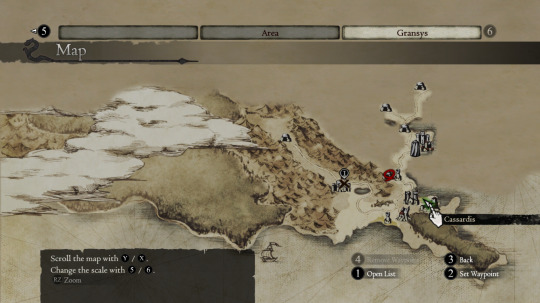
This world is huge, yet the space between major points is bogged down with filler.
There is fast travel in the world of Dragon’s Dogma, thankfully. Unfortunately, you can’t really access it until you make it a good way into the game and can purchase the items that let you warp to certain places you’ve already been. It’s on you to investigate the items you can buy from vendors in order to discover that you can fast travel at all (there is an even worse fast traveling mechanism built into the original version of the game that’s not worth explaining for its lack of usefulness). Fast travel helps make things more bearable, but the fact that it needed to be included (and then improved for the PC release) highlights just how much of a wasteland the game takes place in.
The expansiveness of the world makes for another problem, which is that it’s very difficult to tell if you’re within a reasonable level to kill the enemies and beasts you stumble across. Even the weakest enemies are hard to kill alone. This is done to keep players from steamrolling their way through the game and to account for the possibility of three Pawns accompanying the player at any given time. For any enemy of reasonable strength, you’ll have to chip away at their health bar, focus on areas of weakness to gain an advantage, and manage the battlefield for extended periods of time. Isolated, this makes for interesting scenarios and is the most enjoyable part of the game, by far. It is taken to the extremes much of the time. The amount of damage you deal to enemies that are in your league and those way out of your league is difficult to determine even several minutes in sometimes. This means you can get yourself in unwinnable scenarios pretty quickly if you aren’t careful. God forbid you chip away at a Manticore for thirty minutes before realizing you’re not where you’re supposed to be.
Running into obstacles too difficult to tackle at the player’s current level can be a great way to guide them through the game’s intended route, but it’s at odds with a game that is supposed to allow you to do what you want when you want to do it. Most of the time, fights are really only difficult because you’re simply outnumbered or the mythical creature has a seemingly limitless supply of HP, and not because the enemies themselves are tricky to figure out or have complicated move sets. The flexibility of the combat allowed for through the Vocation system, the target points that exist for the larger enemies, and the adventuring party nature of combat all feel like elements meant for a game more like the original idea for Shadow of the Colossus than an Elder Scrolls style open world RPG and makes it feel as though progress is never really being made.
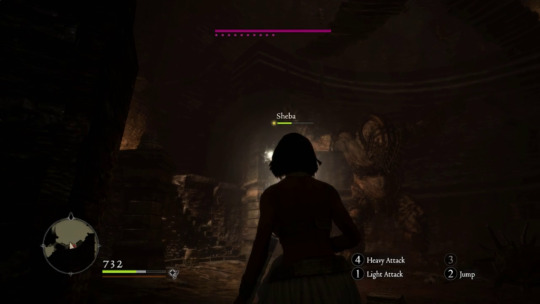
The dots represent the number of health bars this guy has.
There’s no easy cure for this sort of design. Dark Arisen has an additional component, Bitterblack Isle, that feels like the counterpoint to the main game. It offers a nice respite from the mind numbing openness by being more focused and self contained. You are taken there and you just have to dungeon crawl and kill everything. You are free to explore, but progression is more carefully planned and feels both genuine and rewarding. Sadly, Bitterblack Isle’s difficulty as a whole makes taking it on in the early game a pretty extreme exercise. I spent roughly half my time playing on Bitterblack and it was ruthlessly punishing for my characters. By level 30 I managed to find a bit more success, but getting to that level on Bitterblack alone would have meant cheesing the easiest of the island’s enemies hundreds of times. Given the choice of doing that or doing the main quest, I felt forced back into the main quest where I could get experience for far easier, if crushingly boring tasks. This pretty much killed any motivation I had to keep playing.
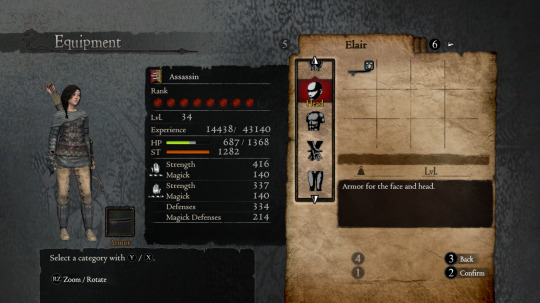
I probably had the most fun decking my character out in equipment more than anything else.
Maybe that’s my problem with open worlds. For all there is to do, games like Dragon’s Dogma seem to rely purely on the will of the player to push them forward, even when their designs seem to actively discourage moment to moment enjoyment. There’s something exploitative about the genre that just rubs me the wrong way. It’s not fair to make me be a messenger boy for an hour just so you can reveal some more details about a plot that barely holds together when it’s finally all presented. No reward in these games will make filler worth it. Games being big for the sake of being big live on the idea that value lies in the sheer amount of time that can be spent playing it, and take it to their most fallacious logical conclusions. I can only hope that in the future I’ll see the warning signs earlier.
2 notes
·
View notes
Text
Thoughts on Sonic Mania
This review/essay assumes that the reader has kept up with the social media releases in regards to the game, such as the reveals of Flying Battery and Stardust Speedway, the videos on the Special and Bonus Stages, gameplay videos of some zones released by Youtube accounts, and so on. However, it will not have any spoilers about zones, mechanics or things beyond this.
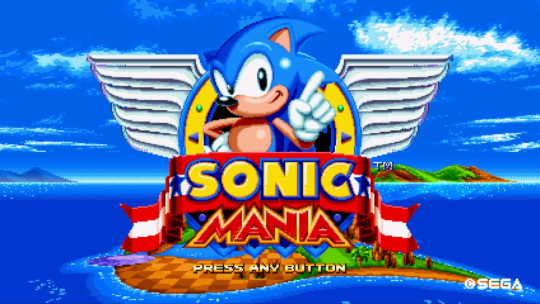
Everyone out there who’s already put out a review or video or whatnot on Sonic Mania has already started off by going into Sonic’s history, ups and downs and so on, so I won’t bore you with that. Everyone already knows about Classic Sonic, Sonic Adventure, Sonic 06 and Boom. There’s more interesting (and relevant) ways to do an intro for this anyway, and the 06/Boom stuff doesn’t bear repeating.
What does bear repeating, then? The fact that Sonic Mania is a very, very good game.
I’ve been a Sonic fan all of my life, starting with renting VHS tapes of both cartoons (AoStH and SatAM, not Underground) from the local Blockbuster, then eventually ending up with the PC versions of Schoolhouse and CD, and I’m willing to admit that, up until very recently, I was never particularly good at the games. As a child I always got stuck around Collision Chaos, and as I grew up and found out about emulation, I never exactly beat any of them, but it didn’t matter to me, because frankly, moving so fast, shooting through loops and the general feeling of momentum was so much fun.
The whole videogame news website meme of “Sonic was never good” thus understandably grates on me. The Sonic social media construct and everything else cracking jokes about his less-than-stellar outings and so on was cute at first, but it quickly gained that poisonous ironic tinge to it, like Sonic would never be able to step back out of the shadow of its own mistakes. Like when you see people on here or Twitter or whatever call themselves “furry trash” or “(X fandom) trash” or so on. Stop doing that. Don’t settle for acting like mediocrity.

Sonic Mania is the opposite of all of that. It feels like the freshest, most interesting, but most importantly, most earnest Sonic game in a long, long time. It was obvious to most people when the game was revealed that the game was going to be something special, and I think the hype for it only grew as time went on, even in the hearts of anyone who managed to be skeptical at first. There were no jokes, no self-deprecating wisecracks or memes, none of that. They simply stood up, head held high, and showed off gameplay after gameplay.
This game is exactly the game that Sonic has needed, now more than ever. This year in general has been great for games (between Breath of the Wild, Nier, Persona, and many other upcoming games like Mario Odyssey and the like), and Sonic Mania is another excellent chip to add to the pile. The sheer amount of passion and love for Sonic as a franchise that the developers (Taxman, Stealth, Tee Lopes and the rest of the Sonic 2 HD crew, and so on) have is palpable, and more importantly, it’s wonderful.
I have experience with Taxman’s work through the excellent Sonic CD port from back in 2011, so when I booted up the game and started a save file as Sonic and Tails, I felt right at home. Controls, as expected, feel very natural, and the physics and momentum are virtually unchanged from the CD port, which itself was already about as accurate as you could possibly get to the originals. I have the Switch version, which meant that I was primarily using the left buttons to play rather than the control stick, and while I would have preferred a normal d-pad, it worked just fine anyway.
There’s something to be said about how easy it was to pick up the game and slip into a groove. I had gone in intending to look at the same the way I had when I streamed Sonic 3 and Knuckles a while back (my first time completing that game, no less), looking at the level design and seeing how the game itself worked. Instead, I ended up getting completely sucked into each and every level I played, and I was completely enamored with the game as a result. While I could see the machine and its cogs all working together, I needed a couple days to cool off and some more time to play it after the initial rush to get my thoughts in order.

I suppose that, more than anything, is what speaks the most to the sheer quality of the game. The levels consist of a mixture of:
Recreated zones from older games, oftentimes with new mechanics or mechanics pilfered and repurposed from other games in the series
And entirely new zones like Studiopolis and Mirage Saloon, with their own unique gimmicks, setpieces and visual themes
And while it’s very easy to organize those things like that, the game itself is far more than the sum of those parts. Mania’s levels absolutely ooze with love and attention to detail, so much so that it took at least two full playthroughs for me to pick up on everything (and knowing me there’s probably more stuff I missed). The game feels like a best-of game, where it takes many of the fan-favorite or memorable things from all four of the classics (1, 2, 3&K, and CD) and mashes them together in order to get the most out of them.
Chemical Plant is probably one of the easiest examples to point to, and it’s just the second level. The second act’s arguably “major” gimmick is the chemical pools that can be altered into bouncy gel (both light blue and green), but it’s not the only gimmick the stage has on offer; there’s also sticky platforms that move on rails, pink bubbles that lift you from one area to another, as well as the classic pipes from the first act and the original zone.
That’s four different small mechanics, and I can happily say that all of them are integrated into the level design in very sensible yet surprising ways. The levels aren’t massive, but there’s still plenty to explore, and thankfully exploration isn’t quite limited to only Tails thanks to the addition of a carry ability you get when playing with Sonic and Tails.
Thankfully, the exploration never feels like it becomes the main focus (partly since the Special Stage rings are the only major thing to find, and partly because the game has a save system), and there were times during my initial playthrough where I was trying to explore but accidentally stumbled into a high-speed place, only to decide to just roll with it (hah) and see what I could find in the next section of the level I ended up in. It speaks to the heart and soul of Sonic as a game and as a character, and it’s a very, very happy feeling.

The game’s difficulty is also worth noting, mostly since it’s probably the smoothest difficulty curve I’ve ever seen in a Sonic game. I’m rather curious to hear how the developers picked the old zones to remaster that they did, since it often feels like they were chosen not just for their memorability and mechanics, but also for where they showed up in their original games. Zones like Green Hill and Chemical Plant are obvious choices; some of the ones that show up later on, when the game starts getting harder and nearing its finale, are not quite so expected, and personally are very welcome surprises.
This also goes for the bosses, which often feel like they were designed more to be interesting and engaging rather than simply difficult. None of them are all that complicated per-say, but around the end of the first third of the game, things start to become much more challenging, and by the final act everything reaches its peak.
That said, I never got a game over and actually ended my first run with my lives in the double-digits, despite having a few deaths in earlier zones and dying a few times to the final boss. I attribute this to the quality of the level design more than anything else, though. Bottomless pits are beautifully rare (aside from a couple sequences in Flying Battery, naturally), and all of my deaths were due to my own recklessness rather than unintentional crushes, spikes or enemy placement.
And best of all, the Special Stages aren’t annoying. In fact, I’d say they’re probably the best in the series, taking the best elements of the previous games’ Special Stages and mashing them together. They get tough, but still quite fair, and are rather exhilarating. The Blue Sphere bonus stages are quite nice as well, though I do kind of prefer the 3&K ones which get you shields and extra rings and lives. Mania’s bonus stages only give you a medal if you win, which counts across all saves towards unlockables, like the sound test and other, more gameplay-related specialties (which, unfortunately, can only be used in the No Save mode).

Also, have I mentioned the presentation? I talked plenty about the attention to detail in the gameplay, but the graphics! The music! Sonic Mania has catapulted itself into my top pixelart-y games ever. It is to 2D Sonic what Symphony of the Night is to Castlevania: rich, colorful, smoothly animated, and full of vibrant details and lots of foreground and background elements that are just as much fun to sniff out and spot as actual secrets in the levels. Seeing all of the goofy EGG TV things in Studiopolis, or spotting the ever-recurring Eggman face logo in various zones (stylized, of course, in the look of classic Robotnik’s face), had me smiling the whole way through.
The music, much like the rest of the game (as I keep repeating) feels like a mixture of the good of everything that came before it, and it’s often the highlight thanks to how the old zones, new zones, and their remixes/music respectively shake up the genres and moods. It’s very similar to Sonic CD’s soundtrack in that regard; the final zone’s music gave me a similar sense of foreboding that Metallic Madness’ US track did, and there’s the obvious, funkier comparisons to draw between something like Stardust Speedway and Studiopolis. And classic tunes remixed, like Chemical Plant and Flying Battery, amp things up nicely.
If there’s one aspect that I do feel like nitpicking, though, it’s the stage transitions. The game has an intro cutscene and does transitions between the acts and zones quite a bit during the first half of the game, but after a certain point things slowly start to go more of the Sonic 2 route of just going from zone to zone, with little tying them together aside from being in older classic titles. Like I said, though, it’s a nitpick, and certainly not enough to really put a damper on how good the game is.

On the whole, Sonic Mania feels like an absolutely triumphant thing, not just for Sonic fans but anyone who loves videogames. It really is like a bolt from the blue (heh), coming at just the right time to remind everyone, fans, non-fans and newbies alike, of just why Sonic was such a massive hit in the first place. By the time I finished my first run, I immediately had the urge to play it again, and the only thing that stopped me was the fact that I really needed to go to bed and get to work early the next day.
As for right now, though? I think I’m off to play through another zone or two of my current Tails run. Gotta speed!
15 notes
·
View notes
Text
Ancestors: The Humankind Odyssey Review - Unfulfilling Journey
New Post has been published on https://gamerszone.tn/ancestors-the-humankind-odyssey-review-unfulfilling-journey/
Ancestors: The Humankind Odyssey Review - Unfulfilling Journey

Ancestors: The Humankind Odyssey sure isn’t afraid of throwing you into the deep end. My first foray into Panache Digital’s survival game began as a young ape alone in a dark forest, the imagined laughs of hyenas and snarls of tigers echoing in the trees in a confusing cacophony. Before I could finish reading the message detailing my very first objective, a warning popped up and demanded I dodge out of the way–of what, I couldn’t be sure. Not knowing what to do, I couldn’t respond in time, and my ape was left alone, scared, hallucinating, bleeding, and poisoned, my screen a milky display of dark green and shifting shadows. I had absolutely no idea what I was supposed to do or where I should go. I began to wander and, thankfully, about 30 minutes later I found the rest of my clan.
At first, I believed the entire ordeal was simply a poor start. As it turns out, that first journey through the confusion of a dangerous jungle, blindly limping in different directions in hopes of finding someone to help me, is a fairly accurate depiction of what your journey in Ancestors will regularly entail. My time with the game saw me suffer similarly disorienting fates over and over, testing me to figure out what I’d done wrong and then do my best to adapt. Ancestors prides itself on giving you as little information as it can and daring you to rely on your ingenuity and resourcefulness to survive. Though the game fulfills its promise to do the former, it fails to deliver a compelling reason as to why you’d even want to rise up to the challenge of the latter.
You play as a member of an ape clan in 10 million BC Africa, and you try to ensure your lineage continues through to two million BC–the time period archaeologists say our ancestors’ evolution finally transitioned us from ape-like beings into a new, more human species. To survive that long, you need to manage how much you eat, drink, and sleep while also steering clear of predators and taking care of injuries. As your life continues, and you interact with more aspects of the world, you grow smarter and acquire new skills, which you can then pass on to your descendants. Upon death, you take control of another ape within your clan and continue the process, striving to evolve into a brand-new, more human-like species before your entire clan completely dies out.
Every second of real-world time translates into a minute in-game–except during sleep, which speeds this equation up. Your in-game progress produces opportunities for further clan evolution to then jump ahead in time by months, decades, or millennia. If you or one of your clanmates becomes pregnant, for example, giving birth to a baby will cause you to leap forward 15 months. For significantly larger jumps in time, exploring as an adult with a baby on your back will allow you to accrue energy to further improve your neurological network and unlock new abilities, which then allows you to advance a whole generation and move time forward a full 15 years. A jump in generation can be followed by an evolution, which moves you to a new, calculated placement on the timeline that’s dependent on which advancements you make. Adapting your metabolism to new plants doesn’t give you as huge a boost, for instance, as learning to use rocks as tools. Evolutions push you ahead tens of thousands of years, providing the most efficient way of getting from 10 million BC to two million BC.
It’s definitely not easy, though, especially since your clan needs to sustain itself throughout those eight million years in a single lineage. Though your clanmates learn what you do in real time, losing an entire clan means you have to restart from a brand-new lineage and relearn everything you’ve previously discovered. If your clan dies after you’ve adapted to eating fish, for example, you’ll not only need to go through the entire process of reacquainting your diet, but you’ll have to teach your new lineage how to make fishing spears all over again. When it’s a few minutes of knowledge lost, it’s not that big of a deal. But when you’re losing hours of progress, it can be quite disheartening.
Instead of saving your skills and knowledge between runs, Ancestors records your progress by keeping track of how far you travel. Initially, you can only begin a new lineage on a cliff within a jungle. However, you can discover and unlock other starting points in the jungle, and even reach other biomes, such as a lake-filled swamp and arid savanna. Unlocking these new start points provides welcome variety–as each environment contains its own unique ecosystem of creatures and plants as well as its own set of weather-based challenges–but your primates always begin in the same clueless state. Even if you already know what to do, you’ll have to retrace your steps and go through the same motions over again to recreate the same conditions that pushed your ape’s neurological network to evolve to where you were in the game before your clan was wiped out–ideally with more of your clan intact this time so you can go further.











This gameplay loop can be immensely frustrating, and it’s one that gets more drawn-out the more you play. By my fourth lineage, it was taking close to two hours to retrace my steps and redo everything I had already had to relearn a few times already. There’s nothing in the game that allows you to recover from a failure and quickly rebuild what’s been lost, either, which is demoralizing when your downfall is your own fault and downright frustrating when it’s just bad luck. I’ve lost entire clans because of my own hubris, sure, but I’ve also lost a clan because, after going through an evolution, the game randomly spawned my clan next to a tiger’s den and there were no materials nearby to make weapons. I spent the final 15 minutes of that eight-hour run helplessly watching my entire clan be slowly devoured before needing to start over.
I couldn’t go back and try a different approach to escaping the massacre of that unfortunate run because there’s no manual save feature in Ancestors. The game saves automatically when you discover a new location or go to sleep, with each lineage tied to one save file. You can manually back up your save to your PC, but there’s no easy or straightforward in-game solution to help you avoid a punishing death.
What small satisfaction the game does provide is consistently ruined by violent predators, though the threat does lessen once you make it far enough into the neurological network’s expansive skill and perk tree.
Having to redo everything you’ve already done also keeps you from discovering new things–which is paramount to surviving and one of the few good parts of Ancestors. With practically zero tutorials, Ancestors forces you to be experimental in order to succeed. There’s joy to be had in bashing different items together to see what happens and then compiling and testing hypotheses. As much as I was frustrated by needing to redo the entire process of creating the aforementioned fishing spear in repeated playthroughs, I felt genuine accomplishment in figuring it out the first time. Most of Ancestors’ puzzles can be solved with logical sense, so the challenge comes in figuring out where to find the materials you think you need. Granted, this being a game, there are occasionally arbitrary hurdles you need to jump through to build certain tools, but you’ll typically only find these associated with more advanced, late-game tasks.
You don’t get to enjoy much of the satisfaction in discovering new things and regularly evolving, though. Predators repeatedly sneak up on you and interrupt your efforts, which typically causes you to drop whatever you were messing with. It’s disheartening to want to explore and forge new tools, only to then have to put your odyssey on hold to limp back to your clan and deal with your injuries–and then be attacked again almost immediately upon heading back out. Yes, the jungle is a dangerous place. But when a tiger leaps out of the reeds to aid a crocodile that’s trying to eat me, it’s a stark reminder of how Ancestors upholds the need to rise to the challenge of survival above the experience of evolution. Historically, it makes sense, as our ape ancestors undoubtedly lived many more years as prey than predator. But in the context of a video game, the constant barrage of spawning enemies gets in the way of the gameplay loop of learning, responding, and evolving–a roadblock that’s only chipped away at and eventually toppled once you acquire the skills and tools so that your entire clan can work together and put up an adequate defense against the creatures that hunt you. Much has to be done to get to that point, though, so contending with larger predators–especially the collection of deadly wildcats that stalk and pounce on you at seemingly every quiet moment–feels unfair early on, especially in areas where there are no trees to escape up into. Dealing with their near-constant attacks or the wounds they inflict can make it discouragingly difficult to actually experiment and evolve.
The closest you come to feeling safe while playing Ancestors is when you’re up in the trees. You spend a lot of time in the branches as a result, but unfortunately there’s no easy way to travel between them. You can climb practically anything in Ancestors provided you have the stamina, so scrambling up into a tree is a quick, painless process. However, with no way to easily course correct yourself–and since trees are rarely positioned in a straight line–you typically only get to enjoy a few seconds of fast-paced, energetic movement before you run out of branch, plummet to earth, and possibly break your legs if you were too high up. And that’s a shame, because it’s actually pretty fun to leap from branch to branch once you’ve got the swing of things. There just aren’t many opportunities to use what you’ve learned once you’ve got the mechanics down. Upon leaving the forest, your chances slim down even more, as the follow-up areas are sparse on the first environment’s signature large trees.
Ancestors: The Humankind Odyssey lingers for far too long on its most toilsome aspects. The game does reward initial experimentation, but then asks you to repeat processes over and over again without any means of securing your legacy. It’s an absolute grind to reach the closest that Ancestors has to an endgame goal–survive for eight million years–and one costly mistake, whether the game’s or your own, can erase everything you’ve accomplished. What small satisfaction the game does provide is consistently ruined by violent predators, though the threat does lessen once you make it far enough into the neurological network’s expansive skill and perk tree. But as it stands, investing in Ancestors’ journey demands too much effort for too little reward.
Source : Gamesport
0 notes
Text
Title New Super Lucky’s Tale Developer Playful Publisher Playful Release Date November 8th, 2019 Genre Platformer Platform PC, Nintendo Switch, Xbox One Age Rating E for Everyone – Mild Cartoon Violence Official Website
I’ve been looking forward to delving into New Super Lucky’s Tale since it was just called Super Lucky’s Tale and was an Xbox console exclusive. As a gamer that really loves platformers of every stripe, I pride myself on being able to immediately identify when a platformer has the right stuff. And even though I demoed both versions of the game a few years apart, one thing immediately stuck out to me – New Super Lucky’s Tale is a platformer made for platformer fans. It has precise mechanics, colorful graphics and is simply a joy to play. But even with all of those boxes checked, the question remains – does this game do enough to differentiate itself from the huge field of other retro styled platformers? Or does Lucky the fox disappoint?
This slideshow requires JavaScript.
New Super Lucky’s Tale starts with a dramatic introduction that set the tone of the game respectably. The Guardian Order was created to protect many far flung worlds from chaos when the unthinkable suddenly happens. One of their members, Jinx the sorcerer, apparently goes mad, and wages war on his fellow Guardians. His goal is possession of the Book of Ages. With it, Jinx will have the power to rewrite reality and essentially be unstoppable. A war follows, and the Guardians are defeated and banished from their home, the Sky Castle. Jinx has his minions the Kitty Litter hound them, and eventually the Guardians are found. Just when it seems all is lost, the Book of Ages reacts to the sorcerer’s fell magic, and it erupts in a supernatural explosion. Many pages of the book are scattered to the winds, and fly to various worlds. In the chaos, a portal opens and drags into it the young and impressionable brother of the head of the Guardian Order, Lyta’s little brother Lucky. You will play this young and untested fox as he sets out to right the wrongs caused by Jinx’ madness.
This slideshow requires JavaScript.
Pretty great start, right? I admit I loved the comic cutscenes and the scope of the introduction. Unfortunately, the drama and tension are lost rather quickly once the game actually starts. One reason is that you never get to meet with the far flung Guardian Order as you play the main story. At best you see them huddled around a campfire during load screens. Another reason is that once Lucky takes charge, the story is decidedly childish. I don’t mean that in a mean way, since this game is obviously meant to appeal to gamers of various ages, but the fact remains there’s a distinct change in tone. Thankfully, none of this stops the game from being fun, and I can say with confidence New Super Lucky’s Tale is a very entertaining adventure.
This slideshow requires JavaScript.
Lucky’s goal is to find the missing pages from the Book of Ages. Finding enough in each world will unlock the gate to that world’s boss fight. While there’s only 5 main worlds in the game, each one is totally distinct thematically and serves as a HUB to the stages. You start out at the lofty Sky Castle, then tackle an agricultural world full of hillbilly worm creatures, or take my favorite, a theme park full of ghosts and goblins. Each world is delightfully strange and animated, and none of them was a bore. There’s a handful of stages in each, including both 3D and 2.5D levels, as well as optional challenge stages. Challenges can range from statue ice puzzles to rolling around in a giant pinball machine. My only complaint with regard to this structure was that I assumed each world would get progressively larger, but in truth almost every world has the same amount of stages. The key difference is that in general it will cost a bit more pages to unlock each subsequent boss fight, but even then it’s a small difference. I only complain about these details because I was so enjoying myself in the game, and wanted an excuse to spend more time there.
This slideshow requires JavaScript.
But just because I want more game doesn’t mean I didn’t enjoy the gameplay in New Super Lucky’s Tale. I haven’t played a platformer this precise and fun in a long time. It’s both simple and finely tuned. You can jump with B or double jump with a second press, attack with a tail swipe using Y, burrow into the dirt with ZR (or slide on hard surfaces), move with the left stick and control the camera with the right stick. That’s it, and that’s all the game needs. I never had any issues getting the controls to work, and found the camera to be very intuitive and easy to use. I also really enjoyed the burrowing mechanic, not least since it helped differentiate Lucky from other platformer protagonists. Once you start, you’ll keep burrowing until you release ZR, but other than that you have complete freedom to move around and collect hidden coins. It’s also fun watching Lucky burst out of the dirt like some landlocked dolphin when you stop burrowing. Most enemies in the game aren’t much of a threat, consisting of angry insects, cranky crustaceans, bothersome bats and other assorted nuisances. Instead, most of the danger comes from stage hazards, such as fireballs, dangerous spikes, or simply falling to your death. Luckily, the game is pretty generous with hearts that restore your health.
This slideshow requires JavaScript.
Since the enemies in the game aren’t much of a threat, that means most of the gameplay instead revolves around platforming your way through stages. The 3D stages have goals you’ll need to achieve to escape, such as awakening a giant Golem or wrangling lost animals, while the 2.5D stages are split between basic ones and endless runners. I tended to prefer the purity of the 2.5D stages, though the scale of the 3D stages was nice, but thankfully their large size is ameliorated by lots of checkpoints. I made great use of the camera in those large areas. Each stage, regardless of format, is full of optional goodies that will reward you with an additional page from the Book of Ages. You can acquire one by collecting 300 or more coins, finding all the hidden LUCKY letters and finding a well-hidden page, which is usually gated behind a timed gauntlet. So the maximum number of pages in each stage is 4, and nabbing all of them results in a perfect score. Not to gloat, but I found it incredibly easy to get perfect scores in most stages, though to be fair, there were a handful that required a second or third playthrough. One good example was in Veggie Village, in a stage where I had to find lost Wormal musicians to put on a concert. Two of the letters in that stage were so well-hidden I almost looked online for FAQs to guide me in the right direction. Thankfully, that sort of confusion was far form the norm, and I raced through New Super Lucky’s Tale at a brisk clip, usually spending less than an hour per world.
This slideshow requires JavaScript.
For my fellow platformer completionists, I wish I could affirm there’s some big reward for finding everything, but I have yet to confirm that from the developer. All I know is that by finding more and more pages, you’ll unlock more and more outfits for Lucky at Geovanni’s boutique. There’s a ton of ridiculous outfits, and they all make Lucky look even more silly. Most of the game really comes down to how much you like playing New Super Lucky’s Tale, and if you’re eager to 100% it without the prestige of some giant reward. That said, I did enjoy it quite a lot, so I will probably slowly chip away at those hidden challenge stages and try to fully beat every main stage. If nothing else, once you beat the game you’ll unlock another world full of super hard levels, just in case the rest of the game was a bit too easy.
This slideshow requires JavaScript.
I always enjoy a good boss fight, and I enjoyed them in New Super Lucky’s Tale. Each fight is against a member of the Kitty Litter, and they’re a ragtag bunch of deranged kittens. The first one you meet is ninja master Mittens, or there’s Tess the cantankerous mechanic. Then you have the sultry Lady Meowmalade and the dynamic duo of Buttons and Fluffy. And of course, the final boss fight is against Jinx, who to my surprise is also supposed to be a cat. Each and every boss has a lot of personality, and while they all fight somewhat differently, most of the boss battles are a bit too samey. They always involve Lucky evading attacks on the field of battle, then flinging something at the distant boss to hurt them, rinse and repeat. Some battles get really hectic, and a couple even go full bullet hell, but most of them left me wanting more. The primary exception to this format was the fight against Lady Meowmalade, which was both incredibly creative and utterly silly. Anytime I get to fight on a dance floor and avoid disco lasers, I’ll have a big smile plastered on my face. And the fight against Jinx was sufficiently difficult that I wasn’t able to beat him the first attempt. Ultimately, the boss fights weren’t bad, I just hoped for more of the same creativity in them that’s everywhere else in the game.
This slideshow requires JavaScript.
Visually, New Super Lucky’s Tale is exploding at the seams with inventive ideas. Some great examples are country Wormals, wrestling Yetis, mechanical horrors, mind control speakers, ghostly freedom fighters and so much more. The whole game is tied together with colorful art and lots of cartoony enthusiasm. It’s bright, funny and very silly, and I love that. It’s also full of characters with lots of personality, from Greg the somewhat stalkery Mailgolem to the aforementioned Kitty Litter. Musically, the game is pretty different depending on the world. None of the tracks were particularly memorable, but they also didn’t hurt the pace of the game.
This slideshow requires JavaScript.
I don’t have many substantive complaints to make about New Super Lucky’s Tale, more a collection of minor irritations. Though I can’t hold this against the game, it was a bit too easy for more than half of my playthrough. I would usually unlock the boss fight after playing two stages, and had to weigh whether to check out the other stages or just race to the next world. The plot, while interesting initially, quickly peters out. Worse yet, in loading screens Greg the Mailgolem seems to hint that there’s some mystery behind Jinx turning evil, but nothing like that is ever explained or delved into during the main game. And while I did enjoy every minute playing the game, I can’t help but wish there was a lot more game to get lost in. I suppose my best hope is that the folks at Playful are working on a sequel to address many of these issues, but in the meantime these issues kept New Super Lucky’s Tale from getting a perfect score.
Ultimately, as a fan of platformers, I really enjoyed New Super Lucky’s Tale. But since I enjoyed the game so much, I was also hoping for more longevity and more challenge. That said, this is a game that’s easy to recommend for pretty much everyone, even if they don’t think they’re good at platformers. For $39.99, there’s a very enjoyable experience here, albeit a brief one, taking me about 6-7 hours. I think New Super Lucky’s Tale is worth every penny, though if you want more content for your money, you might want to wait for a small sale. That said, I still am very glad I got to play this love letter to the platformer genre, and hope to see more in the future from Playful.
[easyreview cat1title=”Overall” cat1detail=”” cat1rating=”4.5″]
Review Copy Provided by Publisher
REVIEW: New Super Lucky’s Tale Title New Super Lucky's Tale
0 notes
Text
NieR: Automata Ought to Matter
And not just because of my horribly cheesy puns. Do a quick check on the internet - some reviews on Metacritic, a few YouTube videos - and you’ll get the impression that a lot of people were taken aback by the quality of the game. NieR, the original game released in April of 2010, didn’t do so well. It gained a cult following for a handful of reasons that I’ll address later, but the overall consensus suggested that the game wasn’t anything special. Poor combat, lacking visuals and repetition were the most commonly cited problems from review outlets such as IGN and Kotaku. Then along comes an announcement from Square Enix that NieR was in for a sequel and everyone was just a little bemused.
I say all this without having had the benefit of first hand experience. I was an initiate to Yoko Taro when I first plunged into NieR: Automata. Like a lot of others, I picked up the game on the assurances that followed reviews of the sequel. This one was different, they said. Different in a lot of ways. And one of the reasons for that was Platinum games.
Platinum. The studio that focused on action combat games like Bayonetta. Their combat systems sought to provide fun and entertainment, with enough depth for gamers to sink their teeth into should they wish to really understand the mechanics. Their previous games received rave reviews (well… let's forget that one Teenage Mutant Ninja Turtles title. Everyone tries to) so naturally, interest had sparked in their new collaboration before it was even released. Whilst the team up ultimately paid off, there was a sense of trepidation towards the other party.
Here’s where things start to get a little more… different. So you have a studio known for their excellent combat and a game director whose previous game in the same series was criticised for having dull combat. You’ve got the one thing needed to plug up the leak in an otherwise study ship right? All fine, except that ship is steered by Yoko Taro, and this captain likes sailing over rocks just to see how much damage he can do. Damage, in this sense, would be the emotional kind. NieR: Automata thankfully doesn’t suffer at all for Taro’s tendency to go off the map. In fact, that’s when it flourishes. Platinum games provide the base for which a story can be built, in which everything weaves around it perfectly.
When Yoko Taro spoke at the 2014 Games Developers Conference, he made a point of how he writes his stories: “Backwards script writing and photo thinking” he calls them. Backwards scriptwriting is just as it sounds. “It’s the process of creating cause of reason starting with the conclusion of the story.”
I must admit, this resonated with me as a writer. Often, I’ve had people ask me how I create characters or build plots. I always refer to it as a snowball effect. In my head, I begin with one point; a name, a personality trait or a scene. Then I start filling in the blanks. It’s never a conscious process. I hardly ask myself “I wonder what this character was doing when she was three years old?” or “What plot shall we add in order to give her character motivation?” As the ideas snowball, the answers to the questions follow. It tumbles down the hill picking up more snow as it goes.
In essence, this is what I felt when playing NieR: Automata for the first time, and later hearing Taro’s methodology, even with Taro snowballing from the ending. Everything comes together in such a way that when it does fly off the course you were expecting it to take, it still keeps going. It never feels outside the realm of the world you’ve created because everything serves the purpose of reinforcing that world and the characters.
Automata is a game that relies heavily on its characters. It’s world made be ruined, but the characters give it life. 2B and 9S, our initial protagonists, are introduced in the norms: on a mission. And it’s here that Platinum starts showing off its effortless play style. “B fights with class. Even as a beginner, you can tell you have in your hands a seasoned pro. She leaps with a grace and style that should be impossible in the high heels she’s wearing. But we don’t question it. By the end of the prologue, your heart is in your mouth thinking “They can’t possibly die like this?” as they detonate these black boxes they hold in order to complete their mission. But then, not a few seconds later, there they both stand. This tells us two things: one, the mission is above all else. And two, they are artificial. Man-made.
It’s then that everything starts tying into this. The upgrade system: a series of plug-in chips that can be collected, then inserted into your friendly androids for a variety of perks and benefits. The quick travel system, which has your body being stored and reassembled at the new location, your consciousness data being transferred. And the death and retrieval system. You want all your plugin chips after dying? No easy way around it. Go back to the site of your death to find your old battered body, and loot them from your corpse.
It’s a morbid system perhaps, one that other games like Darksouls have used in the past. And whilst Automata isn’t trying to go all Bloodborne on you, it does use these systems to enhance its story. Death isn’t something that just causes a restart. You lose yourself every time. A body is left in the place you failed and you must revisit it in order to gain what you lost. Wonderfully poetic, but also practically in Yoko Taro’s android driven world. If you fail to backup your data to the androids’ main base of operations, the Bunker, you’ll lose all of your data when you do die. Everything, and I mean everything, ties into the logic of this world. It makes it so tangibly real that you can't help but begin to care for these characters.
Who doesn’t play a game wanting the heroes to succeed? There are few exceptions, but Automata goes a step further. In another method of driving home what these androids go through, Taro makes you play the game again. NieR did this of course. To unlock certain endings, various different story requirements are met, and various perspectives need to be seen. Playing the first route of Automata alone is like only eating the crusts off a slice of pizza. You’re only getting the base, not the main sauce and cheese of the story.
But then, I hear you cry, why should someone have to play a game twice (theoretically) to get the most out of the content? Why should it be necessary to look deeper into the story when we get a basic, albeit thought-provoking story in the first route? Let me introduce to you, my dear friend, route B. A simple character perspective switch as it first seems. You’ll notice something upon starting up 9S’s story that you can’t believe you missed before when you first booted up the game: this is the first time we get a title screen. To me, this subconsciously marked the beginning of the real story. We’d just made our way through a ten-hour long prologue. And what Taro and his team do in this playthrough is subtle enough that you don’t think too much about it. The gameplay is once again changed, giving you wider tactical options and a little more access to loot the world now that you know the basic layout. Everything seems normal until you hit the desert area.
The strange cardboard style intermission appears on the screen and for a minute, you’re thrown for a loop. What was that? What relevance does it have to the story at all? So you think about it. And think about it more. Until another reveal comes later on when you reach another new area, and then 9S’s hacking abilities start revealing the inner workings of the supposedly evil machines you’re fighting.
I’m not suggesting that this dual perspective narrative is something that hasn’t been seen before - spoiler warning, that’s exactly how the first NieR game pulled its emotional punches - but it’s the way it’s implemented here that causes the new insights to slowly worm their way under your skin and unsettle you. Taro is setting you up for a fall and getting you through a largely similar playthrough with a breadcrumb trail of promises. “Hey, if you play some more, this might all start to make sense.”
It does, eventually. But only after the player embarks on their third playthrough and- hang on, aren’t we going back to the start? The repetition of the previous two acts lulls you into a false sense of security. 2B’s narration at the very beginning of the game sets you up to think there’s going to be more of the same; “We are perpetually trapped in a never-ending cycle of life and death.” Taro just straight up breaks the rule that is an established feature in video games: a new playthrough is a repeat of the game. Now the game continues, and whilst there are many more shocks to come, 9S has to deal with most of them. The perspective shift seen before becomes a protagonist shift.
I love Automata for doing this. The player has spent so much time with 2B, seen her as the face (yes, face) of the game that losing her is as shocking to us as it is to 9S. It’s expected, but that doesn’t make it any less unbelievable when it does happen. I would argue here that 9S is the main protagonist of the whole game. We see his journey from small sidekick to emotionally broken crusader, fighting for revenge. He’s the smarter one, the one who figures it all out. Yet he can’t handle losing 2B and losing his purpose soon after. He snowballs, just like I would with a story. But his snowball is more the kind that breaks windows then ends up being the base of a snowman.
Two things become apparent from these later acts of Automata’s story. Firstly, Taro knows how attached he wants you to feel to these characters. You could almost say he’s being emotionally manipulative. The false sense of security is ripped away from the player after their two repetitions of the same story, thus the second half of the game feels off the rails and unpredictable even when we can guess what will happen next. Secondly, the story is no less at the forefront of the game's design. You could go as far as to say that the story is one of the main designs of the game. Critics and creators often keep these things separate, the story a secondary thought to the game's mechanics, weaving it around what already exists to hold it loosely together. But Automata’s story defines so many of its gameplay mechanics that it is equally important. The features that run from the early gameplay - the death system or plug-in chips - continue throughout, and then the game uses the multiple playthrough concepts, one which is usually just a shallow attempt at extending gameplay hours, to enhance the story.
The truth is, we don’t see enough of these games anymore. This year's releases have placed a much greater importance on the open world exploration style of gameplay we’ve seen in older RPG’s. Games such as The Legend of Zelda: Breath of the Wild, Horizon: Zero Dawn and Skyrim (which is still being newly released on systems even six years after it’s initial launch) all have good stories. But they aren’t tied into the gameplay as much as NieR: Automata threads it’s narrative into every aspect of the game. Nintendo has shared their philosophy on making great games time and time again. They begin with a fundamental “clear concept and then do as much with that concept as the time will allow” according to Zelda creator Shigeru Miyamoto. And this works brilliantly. There’s no way to say with is better: putting story first, or gameplay first. But what Yoko Taro does is fundamentally the same as Miyamoto states. Instead of taking a gameplay concept and making it the key to the game, with Taro it’s the narrative concept. Though we do not know the exact scene that sparked Automata’s story like we do with NieR’s, suffice to say it would have involved androids, or if we want to get a tad more specific, mechanical lifeforms fighting each other in an attempt to understand life.
Because underneath all the swerves in narrative, the protagonist changes and the lolita dressed androids, there is always that philosophy that 2B starts out with. What is life? And why is an android talking of life if they aren’t considered living beings? NieR: Automata doesn’t allow you to create your own story out of your experiences (though this is very much possible in some of the more open areas of the game), but invites you to question it alongside the main characters. Games are such a unique platform for telling stories and NieR: Automata should be applauded for the risks it takes in its narrative brutality and refusal to treat gameplay and story as two different entities. We need more games that are willing to take risks with the stories they want to tell, and in particular, ones that put so much detail and care into the presentation as they can. Yoko Taro and Platinum games marry together narrative and gameplay in an intrinsic way that gives NieR: Automata its identity. In a landscape of the world, make-your-own-story games, Automata shows why a linear story can still be relevant, and how games are the perfect medium to tell stories that can’t be told through anything else.
And that’s why Automata ought to matter.
Yoko Taro: Making Weird Games for Weird People - https://www.gdcvault.com/play/1020815/Making-Weird-Games-for-Weird
#s; vague hope#nier automata#rambling about automata and trying to sound semi professional#it's not working#sorry people in the tags.
0 notes